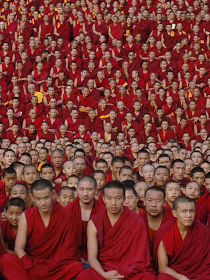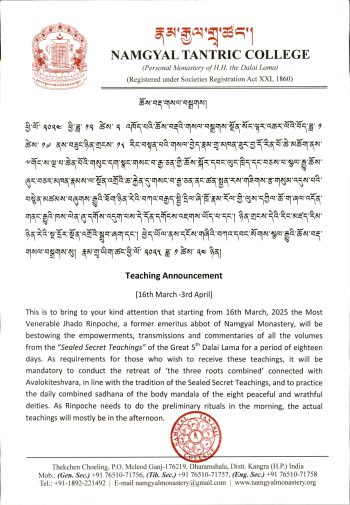- Home
- FPMT Homepage
Foundation for the Preservation of the Mahayana Tradition
The FPMT is an organization devoted to preserving and spreading Mahayana Buddhism worldwide by creating opportunities to listen, reflect, meditate, practice and actualize the unmistaken teachings of the Buddha and based on that experience spreading the Dharma to sentient beings. We provide integrated education through which people’s minds and hearts can be transformed into their highest potential for the benefit of others, inspired by an attitude of universal responsibility and service. We are committed to creating harmonious environments and helping all beings develop their full potential of infinite wisdom and compassion. Our organization is based on the Buddhist tradition of Lama Tsongkhapa of Tibet as taught to us by our founders Lama Thubten Yeshe and Lama Thubten Zopa Rinpoche.
- Willkommen
Die Stiftung zur Erhaltung der Mahayana Tradition (FPMT) ist eine Organisation, die sich weltweit für die Erhaltung und Verbreitung des Mahayana-Buddhismus einsetzt, indem sie Möglichkeiten schafft, den makellosen Lehren des Buddha zuzuhören, über sie zur reflektieren und zu meditieren und auf der Grundlage dieser Erfahrung das Dharma unter den Lebewesen zu verbreiten.
Wir bieten integrierte Schulungswege an, durch denen der Geist und das Herz der Menschen in ihr höchstes Potential verwandelt werden zum Wohl der anderen – inspiriert durch eine Haltung der universellen Verantwortung und dem Wunsch zu dienen. Wir haben uns verpflichtet, harmonische Umgebungen zu schaffen und allen Wesen zu helfen, ihr volles Potenzial unendlicher Weisheit und grenzenlosen Mitgefühls zu verwirklichen.
Unsere Organisation basiert auf der buddhistischen Tradition von Lama Tsongkhapa von Tibet, so wie sie uns von unseren Gründern Lama Thubten Yeshe und Lama Thubten Zopa Rinpoche gelehrt wird.
- Bienvenidos
La Fundación para la preservación de la tradición Mahayana (FPMT) es una organización que se dedica a preservar y difundir el budismo Mahayana en todo el mundo, creando oportunidades para escuchar, reflexionar, meditar, practicar y actualizar las enseñanzas inconfundibles de Buda y en base a esa experiencia difundir el Dharma a los seres.
Proporcionamos una educación integrada a través de la cual las mentes y los corazones de las personas se pueden transformar en su mayor potencial para el beneficio de los demás, inspirados por una actitud de responsabilidad y servicio universales. Estamos comprometidos a crear ambientes armoniosos y ayudar a todos los seres a desarrollar todo su potencial de infinita sabiduría y compasión.
Nuestra organización se basa en la tradición budista de Lama Tsongkhapa del Tíbet como nos lo enseñaron nuestros fundadores Lama Thubten Yeshe y Lama Zopa Rinpoche.
A continuación puede ver una lista de los centros y sus páginas web en su lengua preferida.
- Bienvenue
L’organisation de la FPMT a pour vocation la préservation et la diffusion du bouddhisme du mahayana dans le monde entier. Elle offre l’opportunité d’écouter, de réfléchir, de méditer, de pratiquer et de réaliser les enseignements excellents du Bouddha, pour ensuite transmettre le Dharma à tous les êtres. Nous proposons une formation intégrée grâce à laquelle le cœur et l’esprit de chacun peuvent accomplir leur potentiel le plus élevé pour le bien d’autrui, inspirés par le sens du service et une responsabilité universelle. Nous nous engageons à créer un environnement harmonieux et à aider tous les êtres à épanouir leur potentiel illimité de compassion et de sagesse. Notre organisation s’appuie sur la tradition guéloukpa de Lama Tsongkhapa du Tibet, telle qu’elle a été enseignée par nos fondateurs Lama Thoubtèn Yéshé et Lama Zopa Rinpoché.
Visitez le site de notre Editions Mahayana pour les traductions, conseils et nouvelles du Bureau international en français.
Voici une liste de centres et de leurs sites dans votre langue préférée
- Benvenuto
L’FPMT è un organizzazione il cui scopo è preservare e diffondere il Buddhismo Mahayana nel mondo, creando occasioni di ascolto, riflessione, meditazione e pratica dei perfetti insegnamenti del Buddha, al fine di attualizzare e diffondere il Dharma fra tutti gli esseri senzienti.
Offriamo un’educazione integrata, che può trasformare la mente e i cuori delle persone nel loro massimo potenziale, per il beneficio di tutti gli esseri, ispirati da un’attitudine di responsabilità universale e di servizio.
Il nostro obiettivo è quello di creare contesti armoniosi e aiutare tutti gli esseri a sviluppare in modo completo le proprie potenzialità di infinita saggezza e compassione.
La nostra organizzazione si basa sulla tradizione buddhista di Lama Tsongkhapa del Tibet, così come ci è stata insegnata dai nostri fondatori Lama Thubten Yeshe e Lama Zopa Rinpoche.
Di seguito potete trovare un elenco dei centri e dei loro siti nella lingua da voi prescelta.
- 欢迎 / 歡迎
简体中文
“护持大乘法脉基金会”( 英文简称:FPMT。全名:Foundation for the Preservation of the Mahayana Tradition) 是一个致力于护持和弘扬大乘佛法的国际佛教组织。我们提供听闻,思维,禅修,修行和实证佛陀无误教法的机会,以便让一切众生都能够享受佛法的指引和滋润。
我们全力创造和谐融洽的环境, 为人们提供解行并重的完整佛法教育,以便启发内在的环宇悲心及责任心,并开发内心所蕴藏的巨大潜能 — 无限的智慧与悲心 — 以便利益和服务一切有情。
FPMT的创办人是图腾耶喜喇嘛和喇嘛梭巴仁波切。我们所修习的是由两位上师所教导的,西藏喀巴大师的佛法传承。
繁體中文
護持大乘法脈基金會”( 英文簡稱:FPMT。全名:Found
ation for the Preservation of the Mahayana Tradition ) 是一個致力於護持和弘揚大乘佛法的國際佛教組織。我們提供聽聞, 思維,禪修,修行和實證佛陀無誤教法的機會,以便讓一切眾生都能 夠享受佛法的指引和滋潤。 我們全力創造和諧融洽的環境,
為人們提供解行並重的完整佛法教育,以便啟發內在的環宇悲心及責 任心,並開發內心所蘊藏的巨大潛能 — 無限的智慧與悲心 – – 以便利益和服務一切有情。 FPMT的創辦人是圖騰耶喜喇嘛和喇嘛梭巴仁波切。
我們所修習的是由兩位上師所教導的,西藏喀巴大師的佛法傳承。 察看道场信息:
- FPMT Homepage
- News/Media
-
- Study & Practice
-
-
- About FPMT Education Services
- Latest News
- Programs
- New to Buddhism?
- Buddhist Mind Science: Activating Your Potential
- Heart Advice for Death and Dying
- Discovering Buddhism
- Living in the Path
- Exploring Buddhism
- FPMT Basic Program
- FPMT Masters Program
- FPMT In-Depth Meditation Training
- Maitripa College
- Lotsawa Rinchen Zangpo Translator Program
- Universal Education for Compassion & Wisdom
- Online Learning Center
-
- Prayers & Practice Materials
- Overview of Prayers & Practices
- Full Catalogue of Prayers & Practice Materials
- Explore Popular Topics
- Benefiting Animals
- Chenrezig Resources
- Death & Dying Resources
- Lama Chopa (Guru Puja)
- Lama Zopa Rinpoche: Compendium of Precious Instructions
- Lama Zopa Rinpoche: Life Practice Advice
- Lama Zopa Rinpoche Practice Series
- Lamrim Resources
- Mantras
- Prayer Book Updates
- Purification Practices
- Sutras
- Thought Transformation (Lojong)
- Audio Materials
- Dharma Dates - Tibetan Calendar
- Translation Services
- Publishing Services
- Ways to Offer Support
- Prayers & Practice Materials
-
- Teachings and Advice
- Find Teachings and Advice
- Lama Zopa Rinpoche Advice Page
- Lama Zopa Rinpoche: Compendium of Precious Instructions
- Lama Zopa Rinpoche Video Teachings
- ༧སྐྱབས་རྗེ་བཟོད་པ་རིན་པོ་ཆེ་མཆོག་ནས་སྩལ་བའི་བཀའ་སློབ་བརྙན་འཕྲིན།
- Podcasts
- Lama Yeshe Wisdom Archive
- Buddhism FAQ
- Dharma for Young People
- Resources on Holy Objects
- Teachings and Advice
-
-
*If a menu item has a submenu clicking once will expand the menu clicking twice will open the page.
-
-
- Centers
-
- Teachers
-
- Projects
-
-
-
-
*If a menu item has a submenu clicking once will expand the menu clicking twice will open the page.
-
-
- FPMT
-
-
-
-
-
When you recognize your problem comes from your concept or your concept is the problem, you don’t blame others.
Lama Zopa Rinpoche
-
-
-
- Shop
-
-
-
The Foundation Store is FPMT’s online shop and features a vast selection of Buddhist study and practice materials written or recommended by our lineage gurus. These items include homestudy programs, prayers and practices in PDF or eBook format, materials for children, and other resources to support practitioners.
Items displayed in the shop are made available for Dharma practice and educational purposes, and never for the purpose of profiting from their sale. Please read FPMT Foundation Store Policy Regarding Dharma Items for more information.
-
-
FPMT Community: Stories & News
20
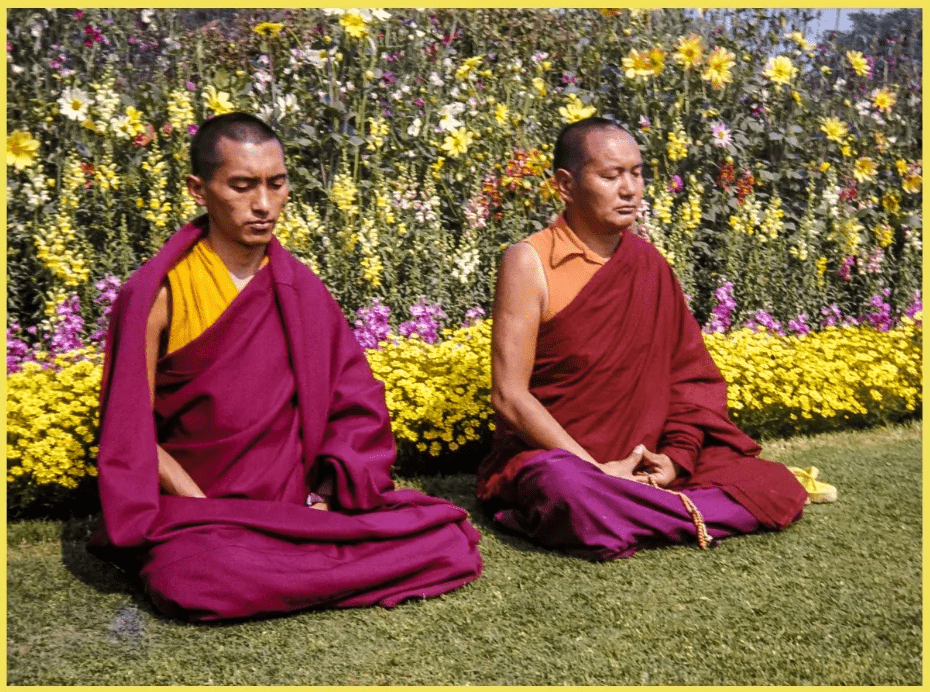
Lama Zopa Rinpoche and Lama Yeshe meditating in Delhi, India, 1975. Photo by Nick Ribush, courtesy of the Lama Yeshe Wisdom Archive.
We are so delighted to share our FPMT Annual Review 2024: “What a Difference We All Have Made Together.”
As you will read in the many summaries included in the review, we continued to offer access to our lamas’ teachings; kept the international community connected and informed about news and advice; offered guidance and structure to FPMT centers, projects, and services; facilitated charitable giving to many beneficial initiatives dedicated to helping others and based on the wishes of Lama Zopa Rinpoche; and disseminated the Dharma to all who wish to receive it.
Ven. Roger Kunsang shared in his CEO letter: “In recent times Rinpoche often mentioned how he felt the FPMT community around the world was more compassionate. Lama Yeshe called it the “family feeling”. Maybe they meant something similar? Think about it for a little while … So many people are more kind, compassionate, and wise. So many animals and insects have been blessed and saved with a chance of a better rebirth. It is very difficult to understand what a difference we all have made together.”
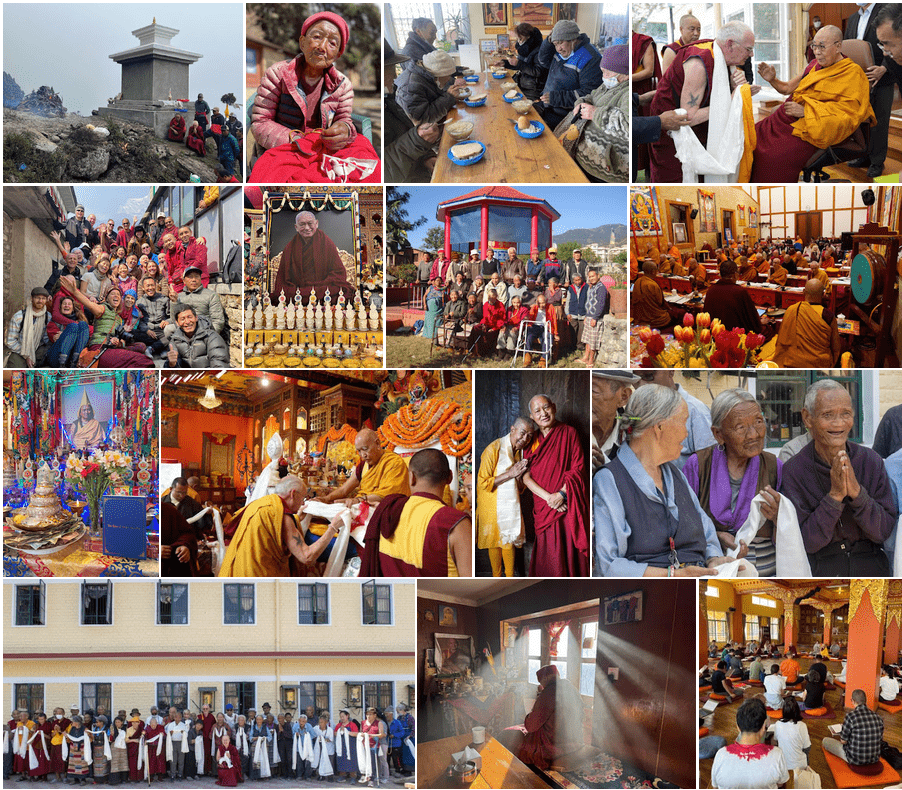
Some photos from this year’s photo gallery.
Please join us in this overview of some of our more notable accomplishments from this past year. This is a critical time in the FPMT organization’s history and we are so happy with and grateful for the enthusiasm and thoughtful engagement from the entire FPMT family as we work together to actualize the wishes of our lamas, to put into practice what they taught us, and to collectively formulate a plan of success long into the future, in order to create a wiser, more compassionate world. Please read FPMT International Office’s Annual Review 2024.
Please note, the FPMT Annual Review 2024 is available only online:
https://fpmt.org/fpmt/annual-review-2024/
Foundation for the Preservation of Mahayana Tradition (FPMT), is a Tibetan Buddhist organization dedicated to the transmission of the Mahayana Buddhist tradition and values worldwide through teaching, meditation and community service.
- Tagged: annual review, annual review 2024
19
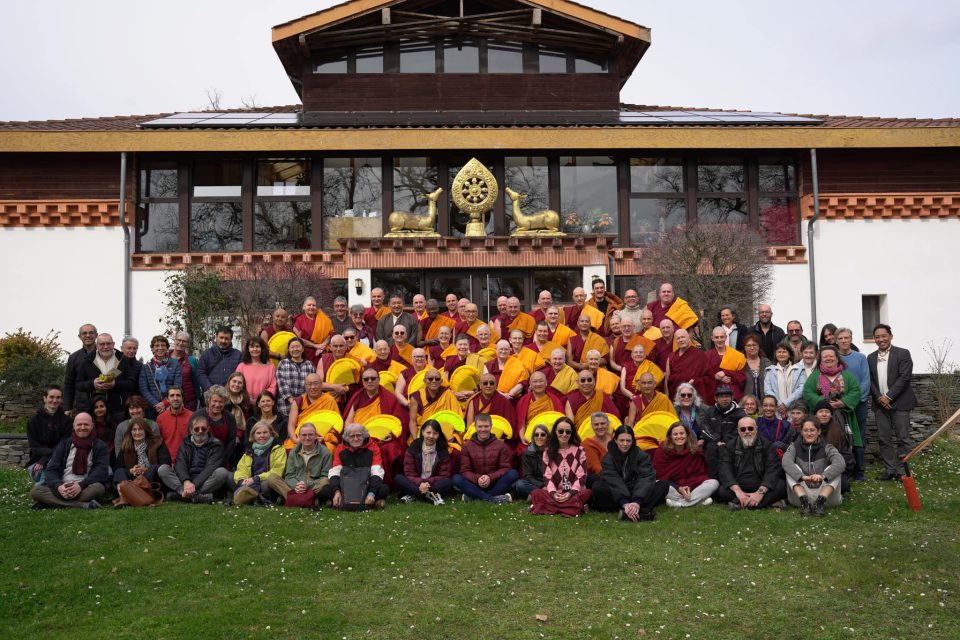
Participants of the Second Gelug Monlam Festival, Nalanda Monastery. Photo courtesy of Nalanda Monastery.
The Second Gelug Monlam Festival was held at Nalanda Monastery in France from March 11-March 15, 2025. Lama Zopa Rinpoche had expressed the wish to bring this special tradition to the West and the geshes and monks at Nalanda made that wish a reality. Director of Nalanda Monastery, Ven. Thubten Sherab, shares the inspiring details:
To implant and extend the new tradition of the Gelug Monlam in the West according to Lama Zopa Rinpoche’s holy wish, is an incommensurable source of rejoicing! Forty monks and nuns including Khenrinpoche Geshe Chonyi (Abbot of Kopan Monastery and member of the FPMT Inc. Board), Geshe Jamphel (Abbot of Nalanda Monastery), Geshe Gyaltsen (resident teacher at Nalanda), Metok Rinpoche, Geshe Loden, Geshe Dakpa, Ven. Steve, Ven. Robina, Ven. Elisabeth and others have actively participated in this second edition. The four and half days of this Great Prayer Festival were graced by the deep impactful voice of Gen Kuncho Namdro, a chant leader from Gyutö Monastery who specially joined us for the event.
Every day, we had more than a hundred participants, the culminating point being Chotrul Duchen, on March 14, the full moon of the Fifteen Days of Miracles.
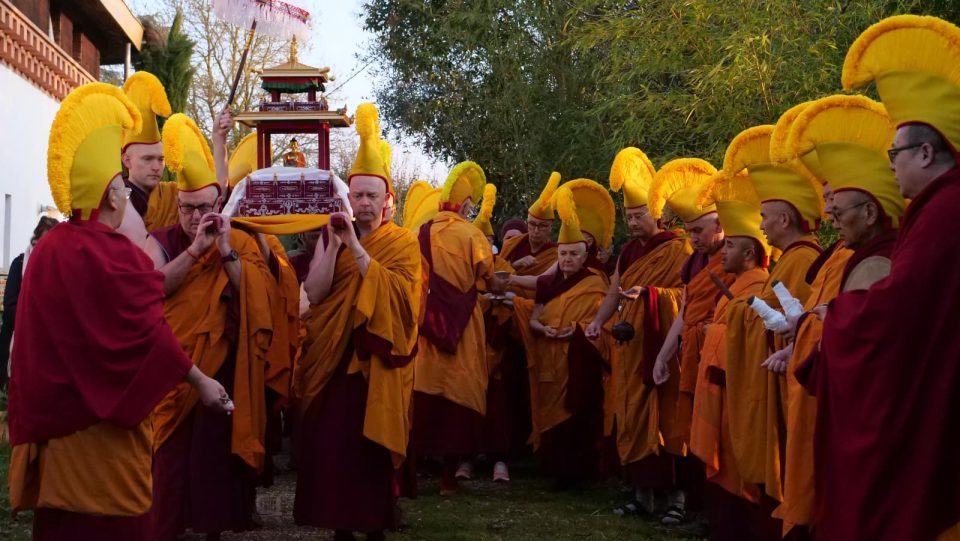
Procession and offering bath to Maitreya during the Gelug Monlam at Nalanda Monastery. Photo courtesy of Nalanda Monastery.
Other prestigious guests such as Thoesam Rinpoche (from Tibethaus in Frankfurt), Antony Boussemart (co-president of the Union Bouddhiste de France), and Thubten Tsering (from the Paris Office of Tibet) contributed to a larger representation of the various Gelug branches in Europe. We also received two supportive video messages from His Holiness Ganden Trisur Rinpoche Lobsang Tenzin and His Eminence Kyabje Dagpo Rinpoche.
Therefore, this year, the seeds of the Gelug Monlam have taken root even deeper, with an event that unfolded very harmoniously.
The Third Gelug Monlam Festival at Nalanda will take place from February 27 to March 4, 2026. More prestigious guests will be in attendance in order to continue to bless and nurture this immense purification and great accumulation of merits dedicated to the swift return of Kyabje Zopa Rinpoche and the long and healthy life of His Holiness the Dalai Lama.
To learn more about the Gelug Monlam, please watch The Seed of Gelug Monlam in the West:
With thanks to Ven. Thubten Sherab for this report, which we share with great rejoicing!
Foundation for the Preservation of Mahayana Tradition (FPMT), is a Tibetan Buddhist organization dedicated to the transmission of the Mahayana Buddhist tradition and values worldwide through teaching, meditation and community service.
13
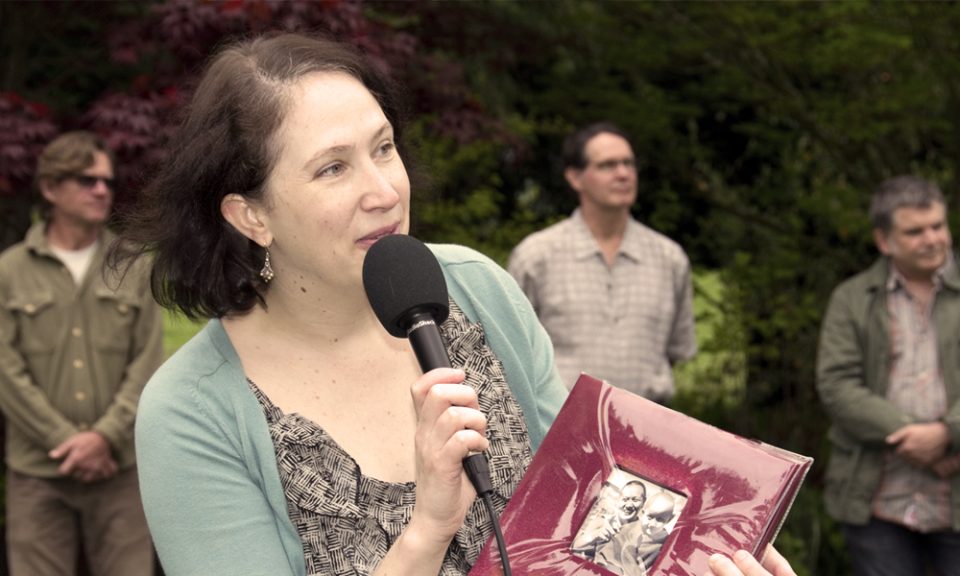
Sara Ritter during the 2012 Maitripa Spring Celebration. Photo courtesy of Maitripa College.
Sara Ritter passed away at the age of 51 on February 6, 2025, from complications from pneumonia.
By Carina Rumrill
As the person who puts together obituaries for fpmt.org and our community news blog, there are inevitably times when I have to organize life remembrances for those I also consider very dear heart friends. Sara Ritter was undoubtedly such a friend.
In 2008, when Sara was publisher of Mandala magazine and one of the editors, she hired me as the new managing editor. The moment I first heard her voice during a phone interview for the position, I thought: “Oh, it’s you!” I had never met her in this life, but I knew immediately that our connection was deep. We did the interview for maybe fifteen minutes before launching into any and every personal detail about ourselves. It was like catching up with an old friend. We both had small boys close to the exact same age; their last names were oddly similar (Bloom and Blumenthal); and we shared so many similar interests, points of view, aspirations, and concerns about the world. And most importantly—we shared a very unconventional sense of humor! As I would learn, many people had this experience with Sara. She knew how to really connect with others.
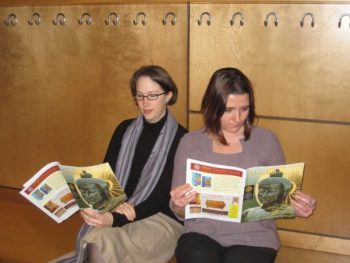
Sara Ritter and Carina Rumrill, 2009. Photo courtesy of Mandala magazine.
On my first day at the job, she scurried into my office with the excitement of a pre-teen girl having her first sleepover with a friend. She wasted no time making sure I was entirely at home and comfortable. She took me and then associate editor, Michael Jolliffe, out to lunch and she was just bursting with ideas and energy about the future of the magazine and a potential membership program to help fund it (which eventually turned into the Friends of FPMT program). Sara was always so full of ideas. She was a big, brave thinker. I marveled at how she conducted herself in staff and management meetings, always so open, fair, courteous, and diplomatic.
I found Sara to be laser-sharp, hilarious, kind, open, deeply emotional, humble, and full of surprises. She was always so present during our interactions: she made me feel like I was the only person alive on the planet when we spent time together. When she was no longer working for FPMT International Office, she was always just a quick trip downstairs at Maitripa College. I continued to run things by her as I found my way managing and publishing the magazine. Her feedback and engagement was always so valuable and thoughtful.
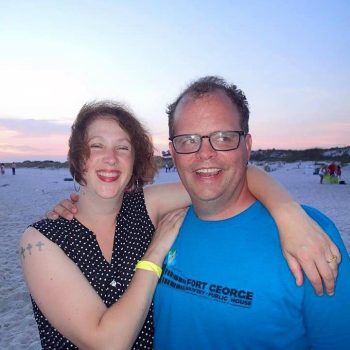
Sara and Tripp Ritter. Photo thanks to Tripp Ritter.
During this time, I was not only working for Mandala and International Office, but I was also a small business owner. Sara supported the upstart of my food truck every single step of the way. She brought her family to eat there regularly and was never shy with constructive feedback or gratuitous praise. She never missed a single community event we organized to support the business and community. She participated in our marketing video when we expanded. She even brought her wedding party and out-of-town family to the truck as part of her post-wedding festivities! She used every opportunity to support others; this was such a central quality of hers.
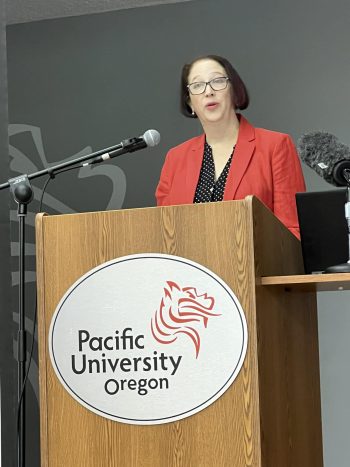
Sara Ritter presenting her final MFA work, 2024. Photo courtesy of Tripp Ritter.
She and her husband, Tripp, and their four kids eventually moved from Portland to Seattle several years ago, and shortly after, I moved with my family to Vermont. We kept in touch through social media, with occasional longer messages updating each other about our busy and complicated lives. Sara had recently completed her Master of Fine Arts in Poetry at Pacific University. Sara was, in her heart, always first, a poet. I am so very pleased that she actualized this core aspect of her identity before she passed.
Her husband, Tripp, opened his obituary for her in the following way:
“The poet Sara Kristen Ritter passed away at the age of 51 ….” The poet Sara. That she was.
Tripp also shared:
“One of her greatest professional and spiritual accomplishments was playing a key role in organizing the three-day environmental summit with His Holiness the Dalai Lama in conversation with spiritual, environmental, and political leaders in the Pacific Northwest hosted by Maitripa College in Portland, Oregon. When she cared about something she gave it her all and ensuring His Holiness had a fulfilling and impactful visit was incredibly important to her. Fortunately, the event was a resounding success.

Sara Ritter greeting His Holiness the Dalai Lama during the environmental summit hosted by Maitripa College, 2013. Photo courtesy of Maitripa College.
“In her professional work and in her personal life, what stands out about Sara is the care she gave to others. So many shared that when she was talking to them, it was like no one else existed. She loved life and love and wanted others to find their own joy. Among her favorite things were being a mom and step-mom, a wife, playing games, listening to music, working together on a crossword, watching a cooking show, and visiting the Oregon and Washington coasts.”
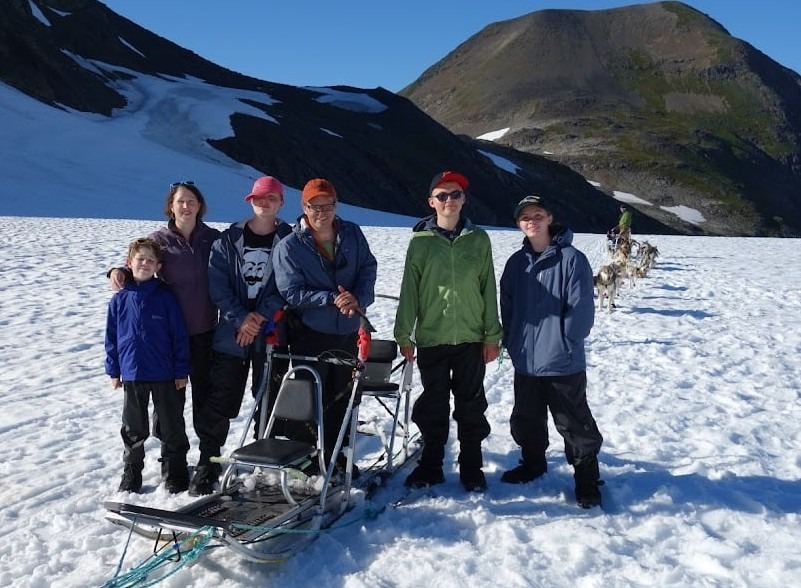
Sara and Tripp Ritter with their children. Photo courtesy of Tripp Ritter.
On February 7, a guru puja was organized for Sara at Maitripa College. Over forty participants joined online and in person. During the puja, Yangsi Rinpoche, President of Maitripa College, said this about Sara:
“Most of us here have a connection with Sara. Particularly myself—at the beginning, when I first came to Portland, Sara was my host. And then she was involved in the establishment of Maitripa very intensely. She played a very important role in student services. She was a really wonderful person and a sincere practitioner, and she served all of us. Sara is very close to our hearts, very dear to our hearts. Today we make prayers and dedicate for her journey, for her future, and for her to have perfect conditions to meet her spiritual path, the path that leads to benefiting sentient beings. And then also for Ben [her son], who we have known his entire life, who is also a part of our family. And for all of her community and relatives and friends who are going through difficulty now, that this difficulty can be part of a spiritual transformation.”
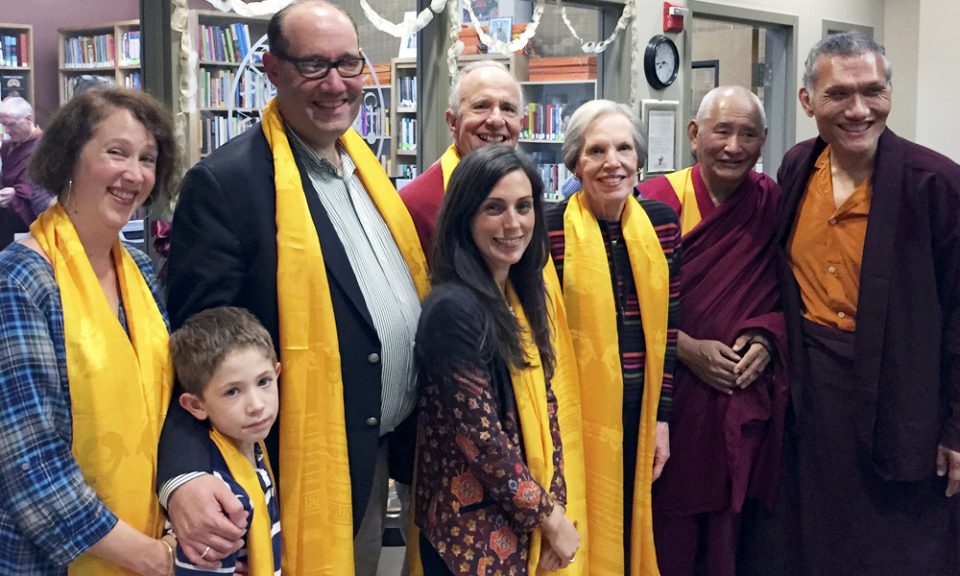
Sara, her son Ben Blumenthal, Tom Blumenthal, Tiffany Blumenthal Patrella, Jack Blumenthal, Susan Blumenthal, Geshe Tenzin Dorjé, Yangsi Rinpoche – at the dedication and opening of the James A. Blumenthal Library at Maitripa College, October, 2015. Photo courtesy of Maitripa College.
Namdrol Miranda Adams, Dean of Education at Maitripa College, and Leigh Miller, faculty member and Director of the Master of Divinity Degree and Chaplaincy Program recalled this about Sara:
“Since the announcement to the Maitripa College community that Sara had passed, many messages have flooded in with a common, cherished remembrance—that of Sara’s unfaltering kindness towards everyone. Many also recall her heart for service, be it towards students, or teaching meditation to prison inmates, or hosting opportunities for rejoicing in the community and life celebrations of others. As a mother, she glowed with love and pride for her son, and kept his drawings and photos by her desk. She was fun-loving, with an uninhibited laugh, putting others at ease and bringing smiles to all.

Sara during the 2008 winter “prom” at Maitripa College. Photo courtesy of Maitripa College.
“Those of us who worked closely with Sara in the Maitripa College office saw many additional good qualities. While she started here as a student, she soon selflessly put her own coursework aside to facilitate the educational experience of other students, becoming the Director of Student Services. In this role, she was a warm, welcoming presence to all, helping them obtain housing, visas, scholarships, referrals to Buddhist-friendly therapists, and more. She invented and, for several years, brought to fruition the Portland City Sit, a day of meditation for all in Portland’s Pioneer Courthouse Square. And when Maitripa College faced an existentially threatening gap in leadership in 2012, Sara bravely and tirelessly stepped up to tremendous responsibility and management of people, communications, and strategic planning, without complaint or expectation of reward. Following that crisis, she again worked incredibly hard—with tremendous vision, love, and generosity—on the planning committee for the 2013 visit of His Holiness the Dalai Lama to Portland and Maitripa College. She was appointed the staff lead in planning the interfaith event, with spiritual leaders representing Indigenous, Jewish, and Christian communities, as well as incorporating a youth choir, Native drummers, and a flower offering by children to His Holiness. Throughout those endlessly long work days over many months, she kept foremost the benefit to thousands of people, and to Maitripa College, of receiving His Holiness, and even when our bodies were tired, her mind was uplifted and encouraging.
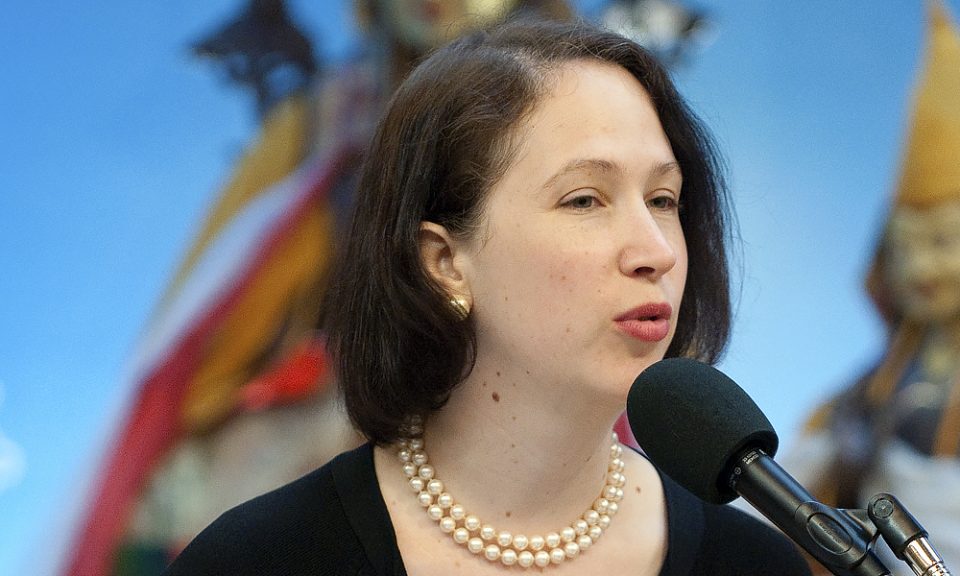
Sara speaking during the 2011 Maitripa College graduation. Photo courtesy of Maitripa College.
“She modeled how to be a bright, caring, professional woman. She skillfully aligned her work responsibilities with our commonly held organizational values and spiritual motivations, achieving not only proficiency and accountability, but also fostering loving care for all in the community. When she departed from employment at Maitripa College, we were saddened but also rejoiced in her new opportunities, marriage, and thereafter, relocation to Seattle. Sara remained a friend, visiting on important College occasions, and staying in touch. She is so lovingly remembered. We are grateful for all the blessings she brought us in touching our lives.”
Louise Light, Maitripa College Graphic Designer and Webmaster, reflected:
“Sara loved a good party—not only working to envision themes and help make the annual celebrations happen, but enjoying them fully. As I recall, the Maitripa College ‘City Sit,’ which brought meditation instruction to downtown Portland, was also a project dear to her heart.

Sara during Maitripa College’s Mad Hatter’s Tea Party Spring Extravaganza, 2009. Photo courtesy of Maitripa College.
“On a personal note, Sara’s presence during my daughter Namdrol’s health crisis over many months in 2011 and 2012, was priceless. Yangsi Rinpoche talks about how she was critical support in the office in Namdrol’s absence, but to me, she also was a personal support. She arranged for community members to pick me up at the airport when I arrived from the East Coast, care for me, and drive me to the hospital, and then, as if by magic, for days, someone would arrive at the hospital to drive me to the house for showers and a change of clothes. Sara also communicated to my larger family and Namdrol’s vast network of global friends by filtering updates Namdrol’s treatment and prognosis through one e-list that she coordinated with me and Rinpoche. I’ll never forget Sara’s kindness that year.”
Former associate editor of Mandala, and alum of Maitripa College, Michael Jolliffe observed:
“When I think about Sara, I remember someone possessing a special blend of curiosity, playfulness, devotion, warmth, gentleness, and groundedness. I appreciated her professionalism and positive attitude while serving in her various roles at the FPMT International Office and Maitripa College. I don’t remember her ever complaining about anyone; in my memory, she was consummately diplomatic at all times.
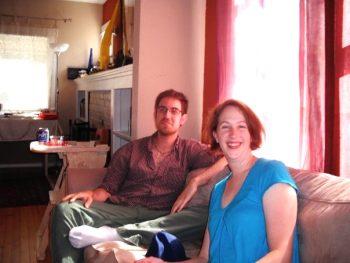
Sara with Michael Jolliffe, 2009. Photo by Molly Stepanski.
“Sara included me in her life as much as she could, and I deeply appreciated the parties she threw in her Portland homes, invitations to game groups at the Lucky Lab pub, and lively conversation at the Horse Brass with her then-new boyfriend Tripp.
“She changed the trajectory of my professional and spiritual life by actively encouraging me to volunteer for Mandala, which eventually transformed into a happy career with FPMT International Office. I have Sara–and her characteristic thoughtfulness and generosity–to thank for the many wonderful experiences I had while working at International Office. She was a truly special person in my life; I’ll really miss her.”
She is survived by husband Tripp Ritter; child Benjamin Blumenthal; step-children Simon Ritter, Bruce Ritter, and Graham Ritter; sister Amy Winkelman; and mother Sheri Winkelman. She is preceded in death by her father, James Winkelman, and Ben’s father, her ex-husband, James Blumenthal.
Compiled by Carina Rumrill with input and care provided by Tripp Ritter, Namdrol Miranda Adams, Leigh Miller, Louise Light, and Michael Jolliffe.
Please pray that Sara may never ever be reborn in the lower realms, may she be immediately born in a pure land where she can be enlightened or receive a perfect human body, meet the Mahayana teachings and meet a perfectly qualified guru and by only pleasing the guru’s mind, achieve enlightenment as quickly as possible.
More advice from Lama Zopa Rinpoche on death and dying is available, see Death and Dying: Practices and Resources (fpmt.org/death/).
To read more obituaries from the international FPMT mandala, and to find information on submission guidelines, please visit our new Obituaries page (fpmt.org/media/obituaries/).
- Tagged: obituaries, obituary
6
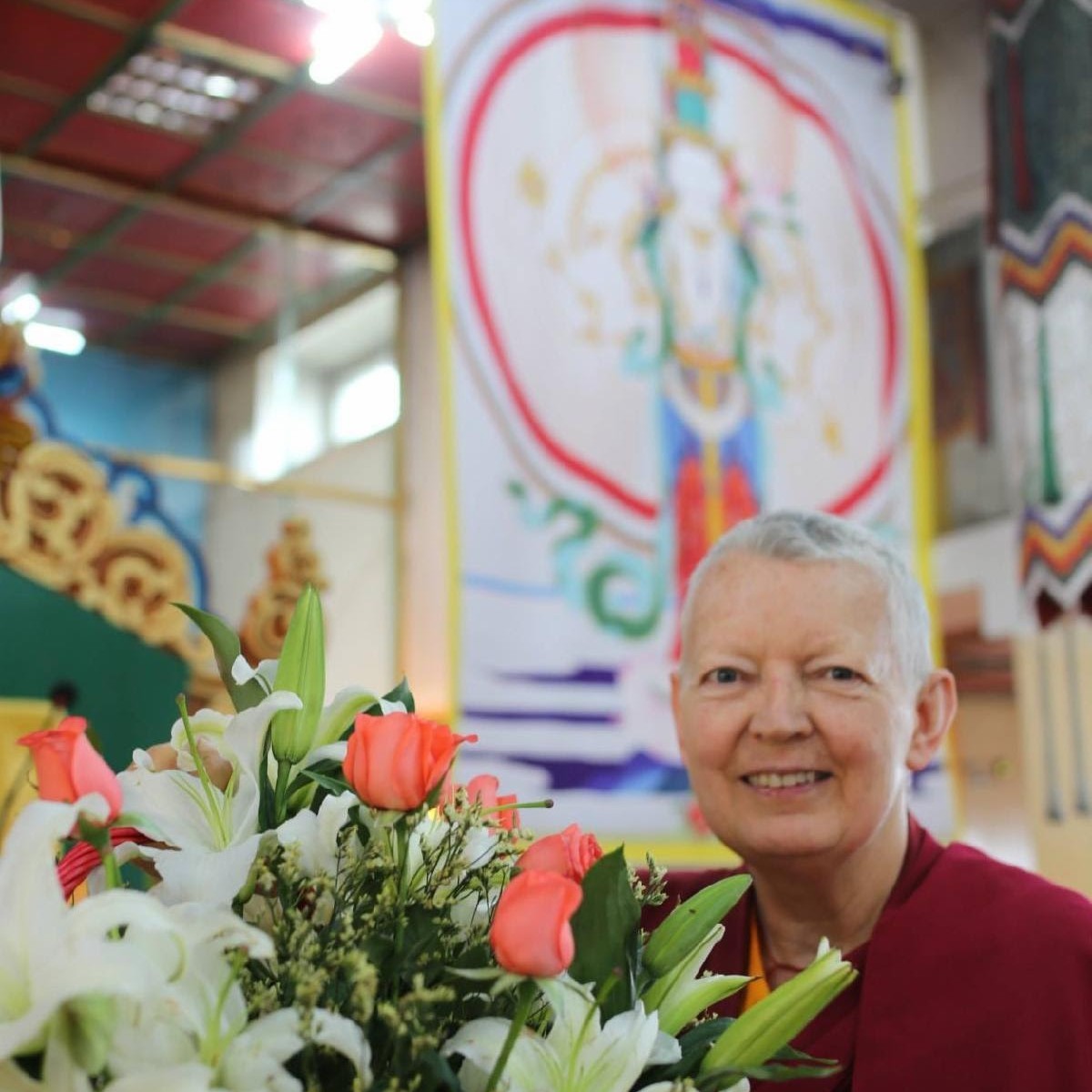
Ven. Ingrid Thubten Nordzin. Photo courtesy Ocean of Compassion Facebook page.
Ven. Ingrid (Thubten Nordzin) passed away after a short period of illness on February 17, 2025 at Tara Home, Soquel, California.
Venerable Ingrid was a beloved and devoted practitioner within the FPMT community for many decades. She received her novice monastic vows in 1988 with Lama Zopa Rinpoche and received full ordination in 1994.
Below longtime friends share some memories, thanks, and wishes for Ven. Ingrid, and tell of the activities being held for her beneficial transition during the 49-day period after her death. We also warmly share below a slideshow by Vajrapani Institute, and an article by Ven. Ingrid, “My First Retreat”, published in the April 1989 issue of Mandala Magazine, with her vivid account of her first meditation retreat in Lawudo, Nepal.
Reflections, Rejoicing and Practices Being Offered
Dear friend to Ven. Ingrid, Thubten Wongmo shares:
“Our dear vajra sister, Ingrid, left this body on February 17 at 4 p.m. I first met her at Kopan before she was a nun, around 1985 and right away we became friends. Since we both have been living in the US, we’ve met at many of Lama Zopa Rinpoche’s courses, both here and in Mexico.
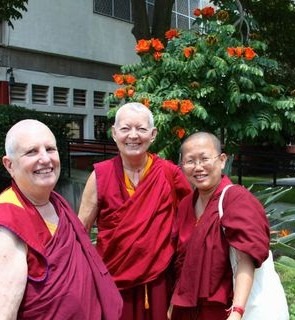
Ven. Wongmo, Ven. Ingrid, and Ven. Tsomo in Mexico, 2014.
“Ingrid was known as the flower lady as she had a talent for creating the most beautiful flower arrangements to place in front of Rinpoche’s throne and on tables next to him. She was very devoted to Rinpoche and would manage to attend as many of his teaching events as possible.
“She had a great sense of humor, and whenever we ended up sitting next to each other, there were lots of laughs. Another talent that most impressed me was her ability to hold pure view. Her closest Dharma friend suddenly stopped all communication with her, thinking that poor Ingrid was the cause of all her problems. This went on for years and even though Ingrid had lost her best friend, she never once criticized her old friend, but insisted that she was Tara incarnate and only acting in such a way as a teaching. Wow wow.
“May our beloved Ingrid be immediately born in a pure land, or be born in a loving Buddhist family, meet the holy Dharma at a young age, find qualified Mahayana gurus, study and practice the path, gain realizations and then benefit many living beings.”
Dear friend, Julie Caldwell remembers:
“In addition to being a nun, Venerable Ingrid was also a teacher. I know this as she was my teacher (along with Lama Zopa Rinpoche) for 22 years. She once told me she had five students. We met in 2001 at The Great Medicine Buddha Retreat and traveled together every year attending Rinpoche’s one month retreat somewhere around the globe. Venerable Nordzin spoke five languages fluently (German, English, French, Spanish, and Greek). In addition to attending Rinpoche’s teachings we would also go to Deer Park in Wisconsin to study with Geshe Lundrub, Sopa.
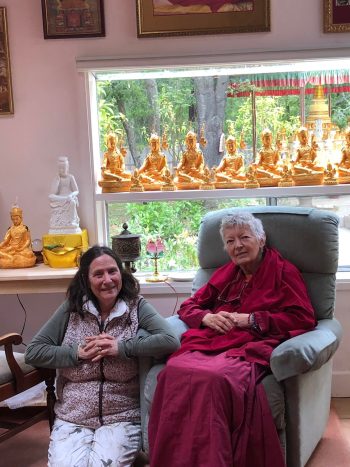
Ven. Ingrid and Julie Caldwell at Lama Zopa Rinpoche’s house, March 2013. Photo courtesy of Julie Caldwell.
“In addition to flower arrangements, Venerable Ingrid was a great artist. She assisted our study group in Elko, Nevada, in designing and building a Universal Prayer Wheel. It won the National Endowment Award for best Park Landscape design. This adventure resulted in her coming to Elko, Nevada many times over seven years, including helping me transform our home into a pure land so Lama Zopa Rinpoche could visit in 2007, and perform the land blessing. This ritual was also attended by members of the Western Band of Shoshone Native Americans. Ven. Ingrid became close with the tribe’s leaders. She also was the artist who drew the hand mudras published in the Vajrayogini Self-Initiation practice.
“Lama Zopa’s Rinpoche also acknowledged her as my teacher on multiple occasions. Perhaps the most profound was during COVID when I did not travel. So I wrote a question for Rinpoche on paper, “Any advice for my husband’s cancer?” And tuned in at 1 a.m. my time to a Zoom teaching he was giving to the students in Singapore. He looked up and said, “The person with the question about her friend with cancer….you know the nun… follow her advice.” Venerable Ingrid was that nun and was known to heal many people with cancer. My husband followed all of her advice and he also is now cured.”
Ven. Angie Muir, on the practices for Ven. Ingrid’s transition: Ven. Ingrid was at Tara Home for her last three days until she passed, which again would have been very comforting for her since this was her wish to pass away there. Many friends as well as the hospice volunteers offered prayers for her there, as well as Ven. Jangchub, who was doing prayers at her bedside as she passed. Fortunately, Yangsi Rinpoche had been nearby teaching at Vajrapani Institute and came to offer prayers for her the day before she passed. She opened her eyes during the prayers and looked at Rinpoche directly for a moment, very aware he was there. It was surely very moving for her.
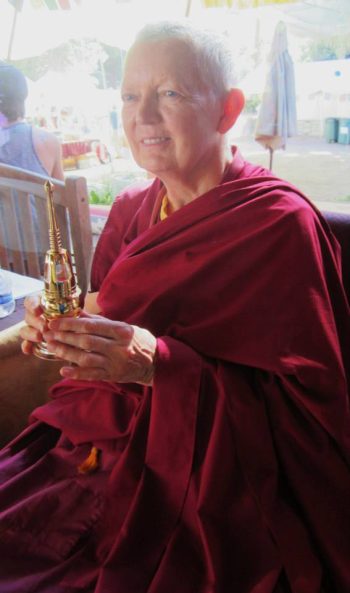
Ven. Ingrid, photo courtesy of Thubten Wongmo.
We held a memorial puja for her on Saturday, March 1, at Land of Medicine Buddha. It was attended by around 50 people, in person and online. We chanted the Medicine Buddha Puja and recited the King of Prayers. This was followed by some heartwarming storytelling of her life and qualities by some of her close friends and Dharma family. At the conclusion, we all enjoyed chai and some of the cakes we offered during the puja, two of her favorites, princess cake and blueberry cheesecake. Land of Medicine Buddha also arranged a beautiful assortment of bouquets which she would’ve enjoyed, being a lover of flowers, especially since there were some of the delightful, sweet-scented spring varieties.
There will be a weekly puja for her up until the 49 day period ends, which will be led by various sangha members in the Bay Area of California. The details for the times and days of the pujas are on the Land of Medicine Buddha website.
We were very fortunate to be able to check with Geshe Ngawang Dakpa, long-term resident teacher of Tse Chen Ling, who advised the time and which direction to move the body. He also advised to make a Shakyamuni Buddha statue on her behalf, which has been completed and will be offered on her behalf to His Holiness the Dalai Lama. Together with Medicine Buddha Practice and the King of Prayers, Geshe Dakpa also asks us to recite the Vajra Cutter Sutra as much as possible during the 49 days.
From the International Mahayana Institute Sangha: From the bottom of our hearts we thank Venerable for all the Dharma and good works for others she has done. For all the beautiful offerings she created, the flowers and holy objects. For her devotion to Lama Zopa RInpoche and all her lamas, for being their hands. We rejoice in her wonderful merit and beneficial life.
Vajrapani Institute prepared a slideshow of Ven. Ingrid’s life for her memorial service
Please read “My First Retreat” by Ven. Ingrid Nordzin, published in Mandala magazine, April 1989.
Please pray that Ven. Ingrid may never ever be reborn in the lower realms, may she be immediately born in a pure land where she can be enlightened or to receive a perfect human body, meet the Mahayana teachings and meet a perfectly qualified guru and by only pleasing the guru’s mind, achieve enlightenment as quickly as possible. More advice from Lama Zopa Rinpoche on death and dying is available, see Death and Dying: Practices and Resources (fpmt.org/death/).
To read more obituaries from the international FPMT mandala, and to find information on submission guidelines, please visit our new Obituaries page (fpmt.org/media/obituaries/).
- Tagged: obituaries, obituary
27
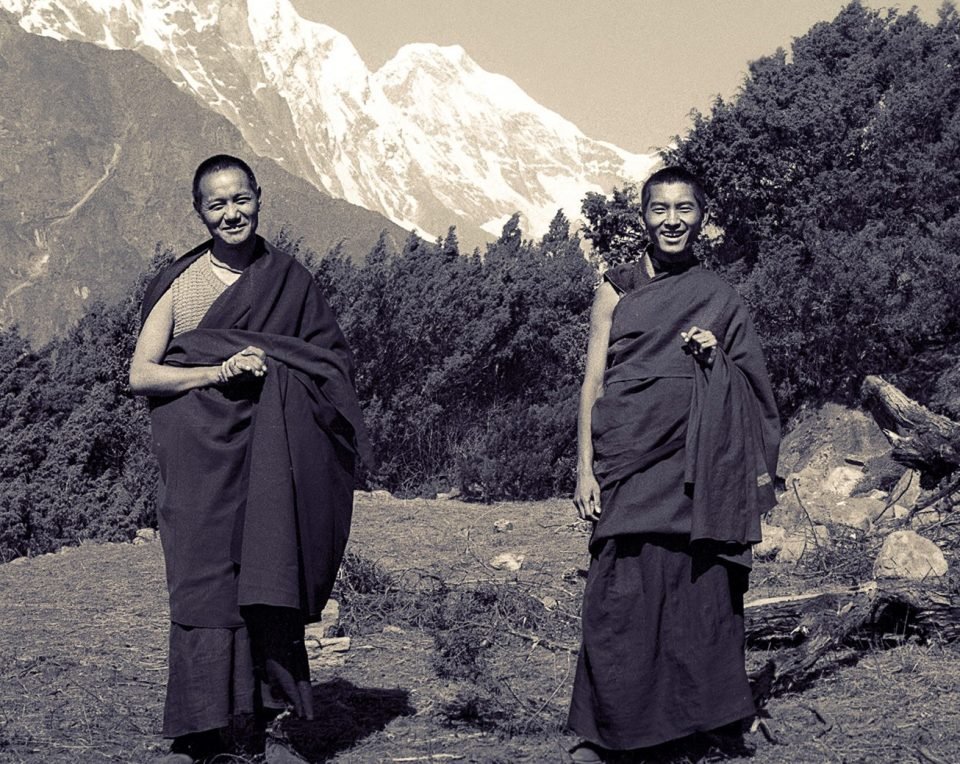
Lama Yeshe and Lama Zopa Rinpoche near Lawudo Retreat Center, Nepal, 1970. Photo by Terry Clifford and courtesy of Lama Yeshe Wisdom Archive.
Losar Tashi Delek!
Happy Tibetan new year to all our dear friends!
With love from everyone at FPMT International Office
The Great Prayer Festival during the Fifteen Days of Miracles—from the first day of the Tibetan new year, Losar, (February 28, 2025) until the fifteenth, Chotrul Duchen (March 14, 2025)—commemorates the special time when Guru Shakyamuni Buddha showed miraculous powers in order to subdue six tirthikas, or non-Buddhist teachers, who lacked faith in him, and to inspire more faith in his followers. It culminates on the full moon, the fifteenth day of the lunar calendar. Please read all of Lama Zopa Rinpoche’s advice for this meritorious period, opportunities to join the worldwide community in praying strongly for Rinpoche’s swift return, as well as advice for observing the anniversary of Lama Yeshe’s passing away on Losar, 1984.
In addition to all the incredible events and programs planned around the world for Losar and the Fifteen Days of Miracles, we want to draw your attention to the Losar Prayer Festival Dedicated for the Swift Return of Kyabje Zopa Rinpoche organized by Root Institute at the Mahabodhi Stupa in Bodhgaya, India beginning on Friday February 28. From the second day onward, beginning Saturday evening local time, February 29, there will be a livestream offered as well as material resources for those who wish to join. Please visit Root’s event page directly for information on the livestream link and all resources for this special event!
Special thanks to the Liberation Prison Project for preparing this year’s Tibetan calendar. A limited view of the calendar is always available on “Dharma Practice Dates” as a courtesy to FPMT students around the world.
Are you an FPMT center, project, or service offering a special Losar and Fifteen Days of Miracles program? We’d love to hear about it and share as a roundup early next week!
Foundation for the Preservation of Mahayana Tradition (FPMT), is a Tibetan Buddhist organization dedicated to the transmission of the Mahayana Buddhist tradition and values worldwide through teaching, meditation and community service.
- Tagged: buddha day, lsoar, merit multiplying day
21
February 2025 e-News is Now Available!
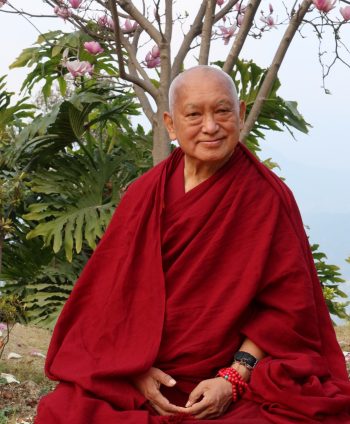
Lama Zopa Rinpoche on Losar, 2021 at Kopan Monastery. Photo by Ven. Lobsang Sherab.
Our February e-news is now available and contains a wealth of information for the upcoming Losar and 15 Days of Miracles period, as well as other news, resources, and causes for rejoicing including:
- Reminder and links to materials pertaining to swift return prayers for Lama Zopa Rinpoche
- Teachings from Lama Zopa Rinpoche and Lama Yeshe
- An update from the FPMT Inc. BOD
- 2024 Grants offered from the Holy Objects Fund
- Disbursement offered to families devastated by the Thame flood
- Eleven Kopan nuns earn geshema degrees
- Resources for your study and practice
- Changes in the FPMT organization
and much more!
Please read this month’s e-news in its entirety.
Have the e-News translated into your native language by using our convenient translation facility located on the right-hand side of the page.
Visit our subscribe page to receive the FPMT International Office News directly in your email inbox.
- Tagged: fpmt enews
19
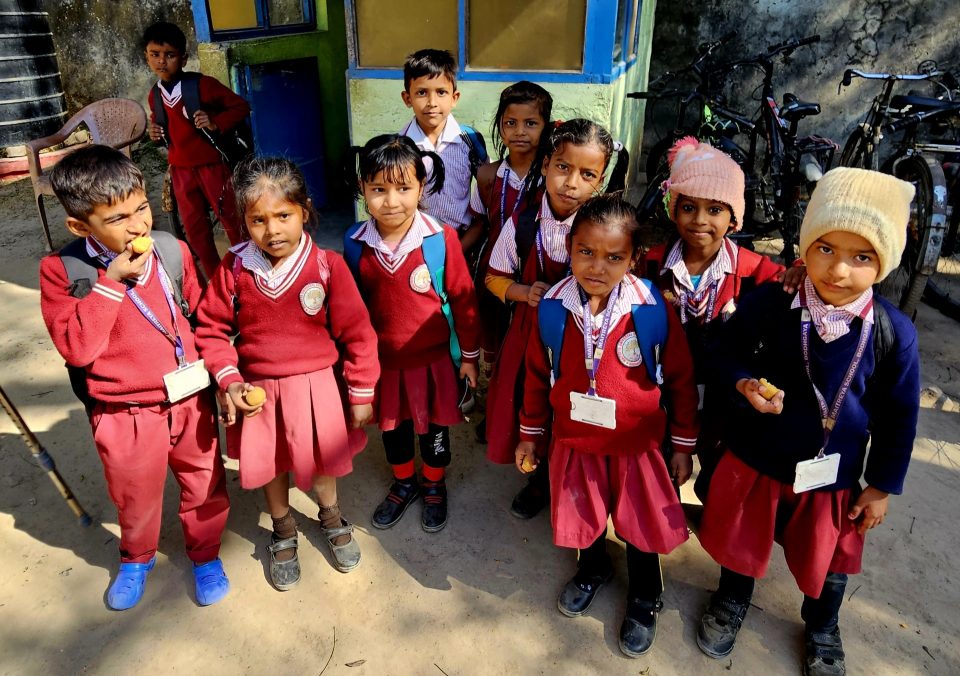
Young students of Maitreya School. Photo by Donna Lynn Brown.
Maitreya School, a project of the Root Institute in Bodhgaya, India, is dedicated to providing quality education while fostering the overall growth and well-being of its 250+ students. The school integrates academic excellence with cultural awareness and personal development through a variety of enriching programs and activities. Recently, former associate editor of Mandala Publications, Donna Lynn Brown, spent extensive time at Root Institute and was inspired by the program at Maitreya School. What follows is a moving portrait of this special school, and the incredible value it offers its students.
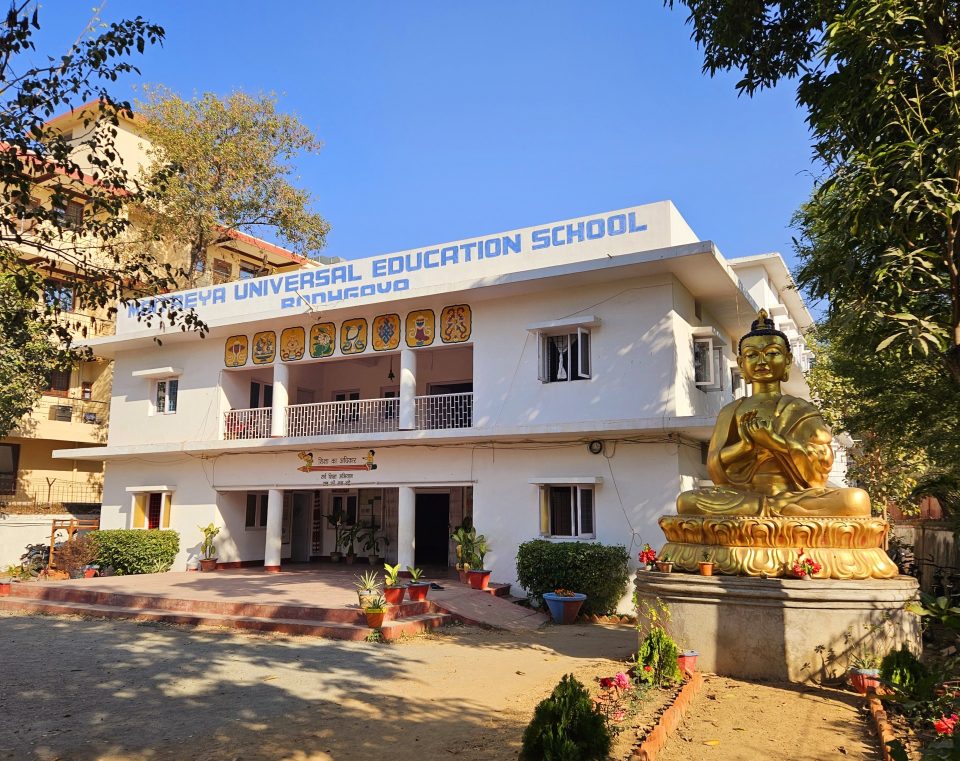
Maitreya Universal Education School, Bodh Gaya, February 2025. Photo by Donna Lynn Brown.
By Donna Lynn Brown
“It was so auspicious,” reflected Kabir Saxena, trustee of Root Institute for Wisdom Culture in Bodhgaya, India. He was describing the visit, on February 6, 2025, of schoolchildren from Root Institute’s Maitreya Universal Education School to the main stupa in Bodhgaya, located where the Buddha attained enlightenment. The children, from grades 6, 7, and 8, went by bus to the stupa with Kabir, teachers, and volunteers to learn about the site and the Nyingma Monlam, a large prayer festival taking place there.
Although the children live in the area, they know little about the stupa. Kabir explained what had happened there and what the children were observing as they circumambulated. At one point, spotting some distinguished friends—a member of the Buddhist Temple Management Committee and a daughter of Tarthang Tulku, Tsering Gellek, who directs the Nyingma Institute in Sarnath, India—Kabir asked some of the schoolgirls if they remembered the Heart Sutra. They had learned it in Sanskrit earlier so they could perform it before His Holiness the Dalai Lama; the school does this every year. There and then, at India’s holiest Buddhist site, Maitreya School’s students chanted the Heart Sutra in India’s holy language. Auspicious indeed!
This inspiring incident is only one of many these days involving the school. Over the last two years the school has been changing to become more child-centered. Many of its students come from households affected by poverty, alcoholism, or abuse. They need trauma-informed approaches. And both brain and trauma research show that children learn better from contemporary pedagogies that support them psychologically and emotionally than from textbook-based lectures. Gradually, the school is implementing activity- and project-based learning: less explaining by teachers standing at the blackboard; more child-focused methods and activities.
Guiding this process is “Kabir Sir,” as the students call him, who is working with Sanjeev Kumar, the school principal, to bring Lama Zopa Rinpoche’s vision to fruition. “Rinpoche gave us many ideas,” he reported. “But the main thrust was to help the children develop spiritually, psychologically, and emotionally while giving them an education that helps them and their communities. Rinpoche thought we should make them like warriors who bring peace and happiness into the world. The last couple of years, fortunately, we’ve had staff and volunteers able to move us in that direction. It’s not fast. It’s day by day, improving the way each class is taught. We work on the teachers’ skills, the resources they can draw on, the way classes unfold. Slowly we make progress.”
Greater attention to the children’s psychological state is one way the school is moving forward. During the 23/24 year, an Indian volunteer from Kolkata, Sanjana, provided many students with counseling. This year, a Canadian psychotherapist, nicknamed Sherpa, spent two weeks working with children and teachers. Through art therapy done individually and in groups, he helped “troublesome” children to develop skills in working with others, avoiding conflict, and handling emotions like anger and jealousy. He also sought to improve the teachers’ understanding of children’s learning processes and to share ways of meeting children’s needs so they have space to learn. “If kids are happy and relaxed,” he emphasized, “they learn better. There’s less resistance, less avoidance, less work for teachers.” He found that “some of the students are really brilliant and talented,” and added, “we don’t want to ignore or waste that. Their futures, families, and society all need them to flourish.” He hopes to come back next year to do more.
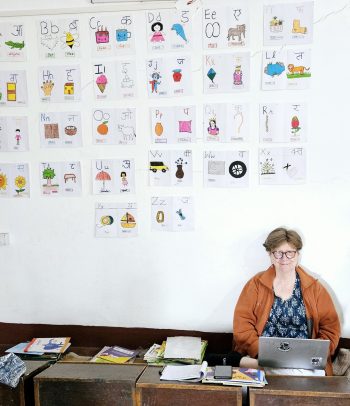
Duffer at her desk in the new library, February 2025. Photo by Donna Lynn Brown.
Another contributor is Duffer, a retired teacher and librarian from the USA. Duffer spent several months in the 23/24 year at the school and has returned for the 24/25 year. For part of 2024, she was joined by her friend and fellow teacher Kim. Kim and she both expect to be back in 25/26 as well. Aided by a young Indian-American man named Vamsi, the friends completely re-established the school’s library in 23/24. Duffer brought and bought books and other resources, and organized the team’s work. They identified needs, sorted useful from outdated or unsuitable items, designed a new room and new shelving, categorized books by subject, catalogued them and entered them into a database, and taught students the purpose of the library, how to find what they wanted, take out books, and keep things orderly. “We wanted to make the library beautiful and the books accessible,” she said, “so the kids would be attracted. It’s working. Some days more want to be there than we can even fit in.”
In autumn 2024, Duffer ran a GoFundMe campaign for more needed items. “We just got in 600 new books in Hindi,” she reported. “That’s a lot of cataloguing, but the books are great. Indian kids’ books may not be as glossy as American ones, but the stories and drawings are terrific. The kids have so much fun with them.” She continues to steward the library and also works with teachers on lesson planning and teaching methods, sometimes co-teaching to help them learn new approaches. As well, she is developing “circle time”: small group discussions to teach the 16 Guidelines, in place of large assemblies, that better support learning by children affected by trauma.

Neelashi cataloguing some of the new Hindi-language books, February 2025. Photo by Donna Lynn Brown.
Neelashi, originally from Rajasthan, has been a staff member of the school since August 2024. She has Masters degrees in both education and Buddhist Studies and is a trained Waldorf teacher. Her main job is working with teachers. She also teaches classes, works directly with students, and attends to students’ physical and psychological health. One concern she has is nutrition. Many students eat little or no breakfast. In 22/23 and 23/24, Root Institute was able to give them, when they arrived each morning, peanuts and bananas—protein, vitamins, and calories. However, grant funding for that program expired in early 2024. Neelashi is trying to raise funds to restore it. She has also applied to Kyentse Foundation for a grant to produce books she is planning to help the children create: books in which they depict their own lives in words and pictures.
Neelashi has found that the students often prefer to learn experientially, not be “just told.” They are eager to figure things out—and giving them the chance improves learning outcomes. So, she indicated, “we have to give them experiences” using images, stories, discussions, games, puppets, and so on in place of lectures. “I work with the teachers on this as a colleague,” she said. “I go in their classrooms, I give examples of how I would teach something.” That way the teachers learn new methods. As well, she mentioned, “we have started adding small things to make the classrooms more energetic, friendly, colorful, heartful. A lot of thought goes into this and it creates a better environment.” She also works with the children to help them learn to relate in healthy ways to adults when their home experiences have been negative. She summed up her role by saying, “The school is in a beautiful place—Bodhgaya—but at the same time, in the most difficult place, one of the poorest states in India, which means education cannot just be English, Hindi, science, math. The regular teachers will do that. But education has to mean other things too. That’s my work. Paying attention to how we are as human beings.”
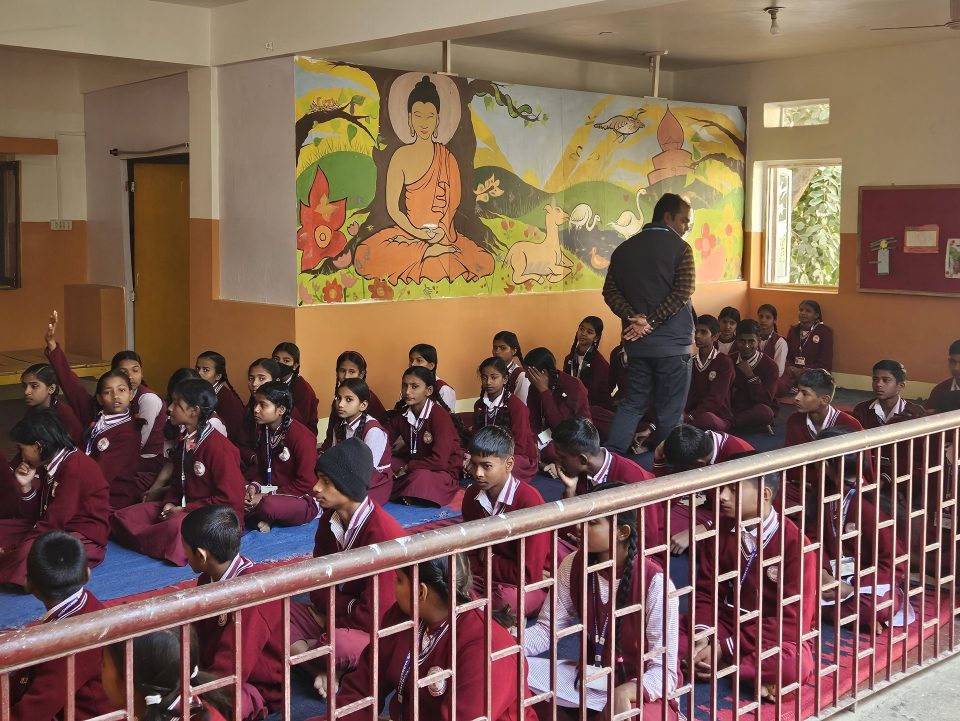
A Universal Education lesson, February 2025. Photo by Donna Lynn Brown.
Will the school continue to evolve? “Absolutely,” said Kabir. “We haven’t fully mastered best practices in teaching, for one. That’s a work in progress. We’d like to teach yoga. Also help the children to better integrate the 16 Guidelines. Rinpoche wanted us to incorporate drama as one way to do that. And we’d like to add some kinds of Buddhist teachings. We are trying as well to learn from other Buddhist-run schools that are improving curricula and methods. We can also better encourage the kids’ creativity to help them contribute to society. There’s plenty to do and I hope to spend the coming decade making it happen.” Added Duffer, “Realistically, the school needs money. We need laptops. Renovations. Better salaries for teachers so, when we train them in new methods, they don’t leave for government schools that pay more. We have great volunteers, but some improvements take money too.”
In early February 2025, Maitreya School had a distinguished visitor: Geshe Lhakdor, formerly His Holiness’s translator and now Director of The Library of Tibetan Works and Archives. Geshe-la gave a talk in Hindi to the teachers and answered their questions, emphasizing the value he placed on the school. When he subsequently gave a Dharma teaching in English at Root Institute, he began by mentioning the plight of Bodh Gaya’s street children. He went on to say, “Root Institute has opened this school, that’s the right thing… there is so much poverty in Bodhgaya. You can walk around the stupa but it is more important to change this place. … Walking around the stupa is still important but we have to help sentient beings. That’s what pleases the Buddha most.” Encouraging words for all who help the school and its children!
You can read more about Maitreya School’s recent utilization of a grant from the FPMT Social Services Fund.
Written by Donna Lynn Brown. Donna is a former Associate Editor of Mandala magazine. She first encountered Lama Zopa Rinpoche and FPMT at a November course at Kopan Monastery in 1996. Recently she completed a Ph.D in which she researched and wrote about FPMT’s social engagement and its intersection with traditional Buddhist teachings.
Foundation for the Preservation of Mahayana Tradition (FPMT), is a Tibetan Buddhist organization dedicated to the transmission of the Mahayana Buddhist tradition and values worldwide through teaching, meditation and community service.
- Tagged: maitreya school
17
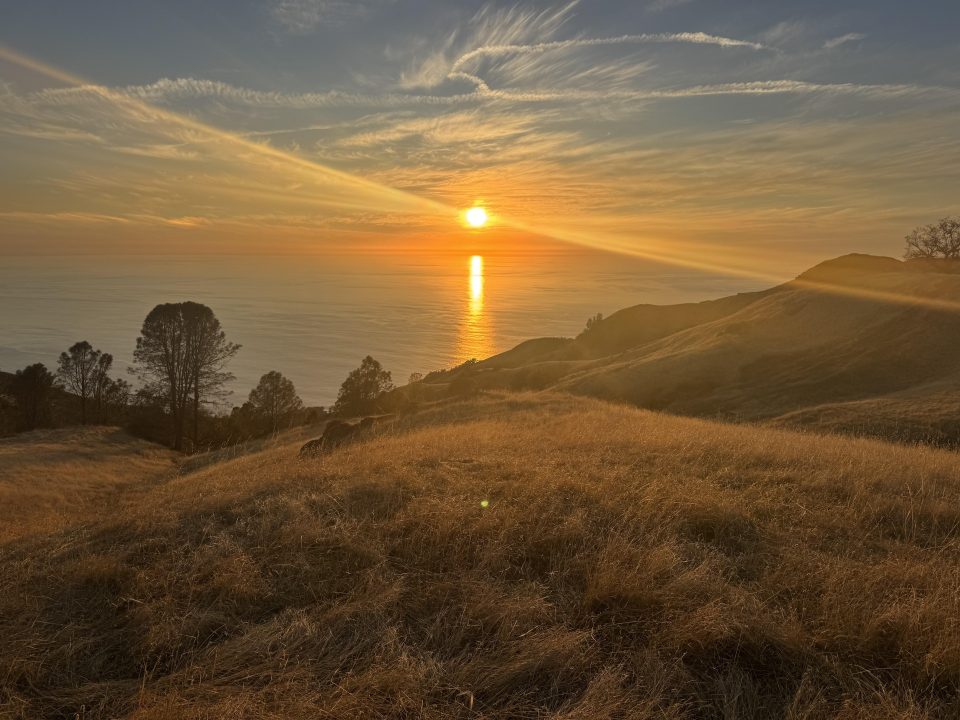
View from Land of Calm Abiding, Big Sur, CA, USA.
“Retreat” literally means to retreat from one’s ordinary day-to-day concerns and view, and to give oneself the opportunity to focus on reality. Away from ordinary distractions, we can train our mind in the path to enlightenment.
FPMT retreat centers span the globe in a variety of beautiful locations and several centers also offer the opportunity to do Buddhist retreats in the heart of the city. Retreat centers offer everything from intensive meditation on Tibetan Buddhist practices to a relaxing environment for reflection and discovery. We are delighted to share an insightful call to retreat by Kolby Graham, director of Land of Calm Abiding in Big Sur, California, USA:
When we check up with our minds, we often become aware how easily we still reify existence around us. So after many years of Dharma study and practice at the feet of our most incredibly kind Vajra Teachers, how is it that we have not yet been able to fully embody the teachings? It seems we might already know the answer: Our minds are not yet serviceable to sustain and cultivate the truth we may only be able to perceive more clearly on occasion.
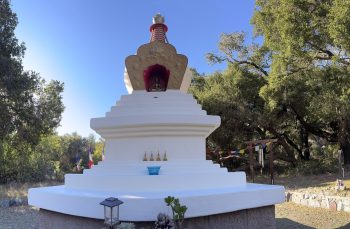
The Enlightenment Stupa at Land of Calm Abiding, CA, USA.
There is, however, a very pragmatic solution that has been hiding from us in plain sight within our own Mandala – sacred hermitages, known to us us as retreat centers. The biographies of nearly all past great yogis reveal the bodhichitta dedication to realizations that come in solitary retreat.
Fortunately, the FPMT organization has many amazing retreat centers that are available to us. Many practitioners may think they can simply insert their Dharma practice into their worldly lives, but this will never be fully possible without first giving up the worldly minds embedded within our worldly lives.
When we fully extricate ourselves to remote and blessed wilderness hermitages for our Dharma practice, we give our minds the opportunity to not distract themselves with the onslaught of endless worldly activities that so easily activate our worldly concerns and steal our chances of maintaining our naturally clear and bright awareness. It is only with this clear and bright awareness that we are able to cultivate genuine lasting realizations.

One of the retreat cabins at Milarepa Center, Vermont, USA.
In this global FPMT Mandala, we have the most amazing conducive conditions for extended or short solitary retreat. There are many centers with solitary retreat facilities including, for example, Land of Calm Abiding in Big Sur California, USA; Vajrapani Institute, CA, USA; Milarepa Center in Northeast Vermont, USA; De-Tong Ling on Kangaroo Island, Australia; Mahamudra Centre in New Zealand; Thakpa Kachoe Retreat Land in the French Alps; Kalachakra Retreat Center, France; Lawudo Retreat Center, Nepal; Rinchen Jangsem Ling Retreat Centre, Malaysia; Land of Joy in Northern England; and Oseling in the Sierra Nevadas of Spain.
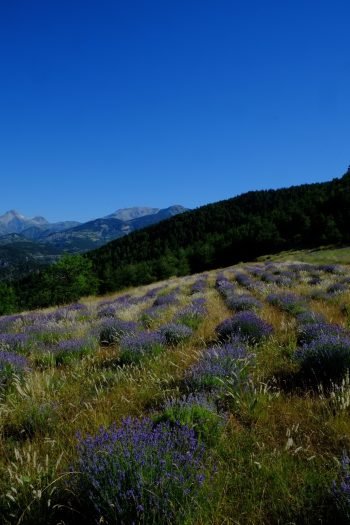
Thakpa Kachoe Retreat Land, France.
All sacred hermitages present the opportunity to abide in retreat from our samsaric modern world and our samsaric minds, within the enchanting soothing quality of vast natural landscapes. It is so rare and so special in these current times to be able to offer Dharma students the unique potential to fully embrace the Path single-pointedly in such a majestically beautiful and supportive environment.
At Land of Calm Abiding, our 525 acres are completely surrounded by National Forest with no human neighbors, and all living needs are taken care of by fellow practitioners honored to bring fresh groceries to the very comfortable private cabins. When one checks up the qualities for conducive retreat in Lama Tsongkapa’s Lamrim Chenmo, one finds them here. Our precious Lama Zopa Rinpoche even made it clear that this is a place to cultivate shinay. On Ribur Rinpoche’s visit, Ribur Rinpoche claimed one day this Land of Calm Abiding would be one of the most important places for Dharma. Presumably this means practitioners will cultivate genuine realizations here. What if by abiding in retreat we finally learn to truly rest beneath the surface of experience without being tossed around by waves of our own illusions. Perhaps then the Principal Aspects of the Path and the Tantric Stages could be synthesized into a moment to moment experience.
As we know realizations won’t come with our ordinary monkey mind. Indeed, without cultivating the clear and luminously knowing awareness of our minds, we will always be susceptible to a “distracted mind resting in the fangs of mental afflictions.” Shantideva made this point quite clear in The Bodhisattva’s Way of Life.

Mountain view from Oseling Retreat Center. October 2017. Photo courtesy of Oseling Retreat Center.
So for those who already have had many years of Dharma study and meditation with guidance from truly remarkable gurus—how do we pragmatically make more effort to abide in these sacred hermitages that are available to us? While the trials of living in the modern world can sometimes make the act of going on retreat seem insurmountable, we only need to look to the biographies and successes of the many yogis of the past for inspiration.
It also seems part of the facilitation of inspiration to shake us from the confusion of our minds needs to come from these great sacred hermitages themselves. Here at Land of Calm Abiding, the only mandatory entrance requirements to our beautiful cabins and land are bodhichitta motivation and guidance from a trusted teacher. Monastics without sponsors are often easiest to raise retreat funds for, but even for our dedicated lay community there are ways to get “noodles rolling up the hill” as mentioned in Pabongka’s Liberation in the Palm of the Hand.

Lama Yeshe and Lama Zopa Rinpoche at Lawudo, Nepal, 1969. Photo courtesy of the Lama Yeshe Wisdom Archive.
On a recent podcast of Skeptic’s Guide to Enlightenment, Scott Snibbe interviewed Paula “Nyingje” Chichester who has abided in long retreats at Milarepa Center, Land of Calm Abiding, a cabin adjacent to Vajrapani Institute, as well as Oseling in Spain. Paula has dedicated her life to the path of a yogi well before, during, and well after her many years of ordination. In the following excerpt from the interview, she very succinctly recalls the advice from a great yogi, Geshe Yeshe Tobden, to her and Roger “Samten” Munro in response to their abiding in retreat with reliance on sponsorship from others:
“He was overjoyed! He even hugged Roger and he said, ‘You must continue to live this way for the rest of your life to prove to Western people that it’s possible, that it can be done, because the biggest obstacle to people gaining realizations is thinking they have to have a job and they have to support themselves. In the West you have places, you have books, and you have teachers, but you don’t have yogis—and you won’t have Dharma until you have yogis! Because Dharma is not in the books.'”
If there is a genuine interest from our side for Dharma to survive in the West and the modern world, then we must hear this call to actually take steps to subdue our minds in retreat. This is a fantastic way to fully repay the kindness of all mother sentient beings and thus the great kindness of our Vajra Teachers.
The dedicated yogi monk Lhundrup Samten (Roger Munro) still abides in retreat. He resides continually at Land of Calm Abiding following the advice of Ribur Rinpoche and Lama Zopa Rinpoche to complete a third Great Retreat as presented in Lama Tsongkapa’s profound ear-whispered lineage teachings. In a recent written correspondence, Ven. Samten elucidated the motivation it takes to leave behind the samsaric mind:
“From the very beginning of my Dharma efforts in this life, the Ten Innermost Jewels of the Kadampa Geshes have been my foundation! I would rather die alone in a cave than follow the limited works for this life only.”
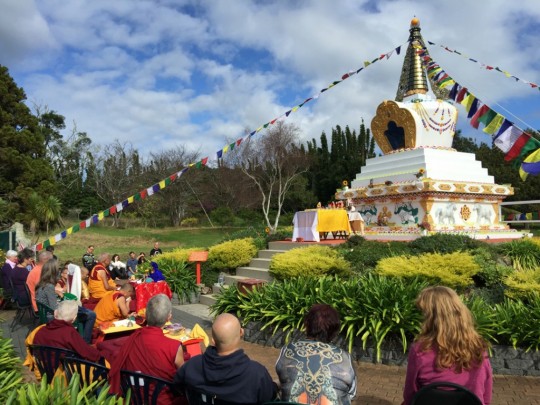
Lama Zopa Rinpoche consecrating stupa at Mahamudra Centre, New Zealand, May 2015. Photo by Ven. Thubten Kunsang.
It is perhaps only this magnitude of dedication that gives enough bodhichitta rocket fuel for our minds to have enough lift off for realizations, thereby allowing us to fully reach the path in this life. At such a point when the samsaric mind has no control over us, we can focus anywhere because we won’t be distracting ourselves anymore! How wonderful to bring such a serviceable mind back into the fabric of our ridiculously entangled and misguided materialistic modern world.
I rejoice that currently I am hearing wonderful echoes in our global FPMT Mandala as well as other Dharma communities, that now is the time to encourage retreat and realizations! Anyone filled with enthusiasm to abide in retreat or support others to do so through much needed financial aid or physical service, please reach out to your nearest Retreat Center.
May we all fully reach the path in this life by following the precious teachings and personal advice of our most kind holy gurus, and thereby bring ourselves and countless mother sentient beings to the peerless state of enlightenment. Sarva Mangalam!
Please explore the many retreat facilities and opportunities available to at FPMT centers worldwide.
Since moving to Vajrapani Institute and meeting Lama Zopa in the summer of 2006, Kolby Graham’s life has been dedicated to cultivating the Dharma. In the Fall of 2007, he left Vajrapani for a tour in India which included two months at Sera Je Monastery for Choden Rinpoche’s transmissions and teachings, followed by a couple weeks at Root Institute with Lama Zopa Rinpoche, and then a couple weeks at Drepung Monastery with His Holiness Dalai Lama’s teachings. From 2009 to 2010 and 2011 to 2012 he served as caretaker at Land of Calm Abiding, and all years following he would come back for periodic weeks and months of helping out on the land or abiding in retreat himself. During the covid pandemic he felt the call to help out at Land of Medicine Buddha in Soquel California as they were very short staffed at the time. His service at LMB in 2022 came to a close when he was asked to serve as Director at Land of Calm Abiding, where he serves and resides today.
Foundation for the Preservation of Mahayana Tradition (FPMT), is a Tibetan Buddhist organization dedicated to the transmission of the Mahayana Buddhist tradition and values worldwide through teaching, meditation and community service.
- Tagged: centre kalachakra, de-tong ling, land of calm abiding, land of joy, mahamudra centre, milarepa center, oseling retreat center, retreat, retreat center, rinchen jangsem ling, thakpa kachoe retreat land, vajrapani institute
11
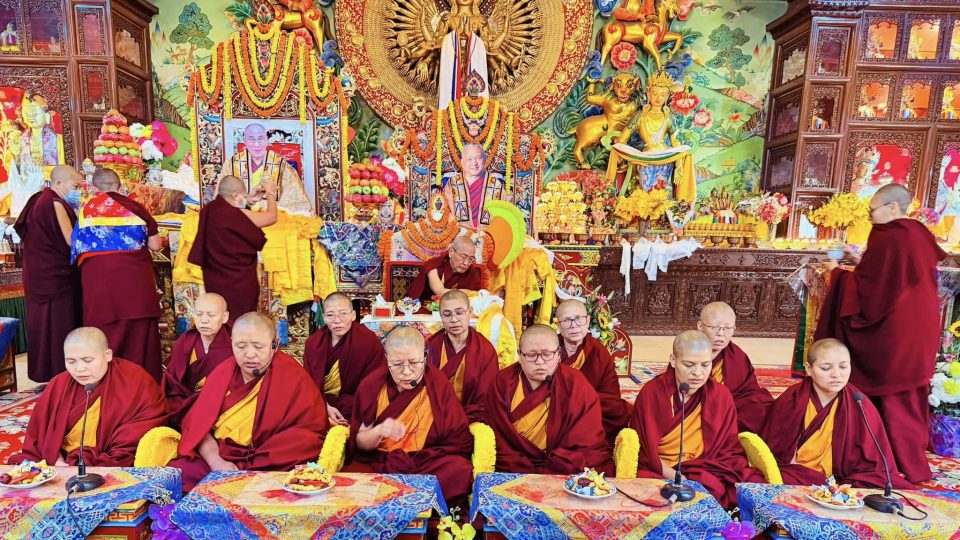
Khenrinpoche Geshe Thubten Chonyi presiding over the celebration ceremony for eleven new geshemas from Kopan Njunnery. Photo thanks to Kopan Nunnery.
On February 3, 2025, eleven nuns from Khachoe Ghakyil Ling Nunnery (Kopan Nunnery) in Nepal successfully completed over 20 years of rigorous Buddhist studies and achieved the geshema degree. They all participated in a special celebration ceremony.
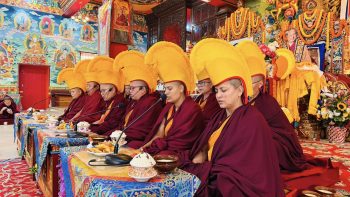
The new geshemas during the ceremony at Kopan Nunnery, February 3, 2025. Photo thanks to Kopan Nunnery.
The geshema degree is the same course of study as the geshe degree, with the feminine “ma” added just to delineate gender. The path to becoming a geshema begins after completing 17 years of monastic study. Those that qualify and desire to move onto the geshema degree path must then complete four years of rigorous oral and written examinations, including a successful thesis defense.
Prior to an historic change in 2012, nuns did not have access to the four-year geshe degree path as monks did. The first to achieve the title of geshema was the German nun Geshema Kelsang Wangmo, who completed her degree at the Institute of Buddhist Dialectics (IBD) in McLeod Ganj, India, a year prior in 2011. A nuns committee meeting was held in 2012, followed with the announcement by the Tibetan Administration’s Department of Religion and Culture that the full degree was now available to nuns.
Please join us in rejoicing in this momentous achievement by all eleven nuns who have worked so hard toward this goal for the benefit of all.
If you have a story to share from the FPMT global community, or news for rejoicing from an FPMT center, project, or service, we are always very happy to receive it.
Foundation for the Preservation of Mahayana Tradition (FPMT), is a Tibetan Buddhist organization dedicated to the transmission of the Mahayana Buddhist tradition and values worldwide through teaching, meditation and community service.
- Tagged: geshemas, khachoe ghakyil ling, kopan nunnery
7
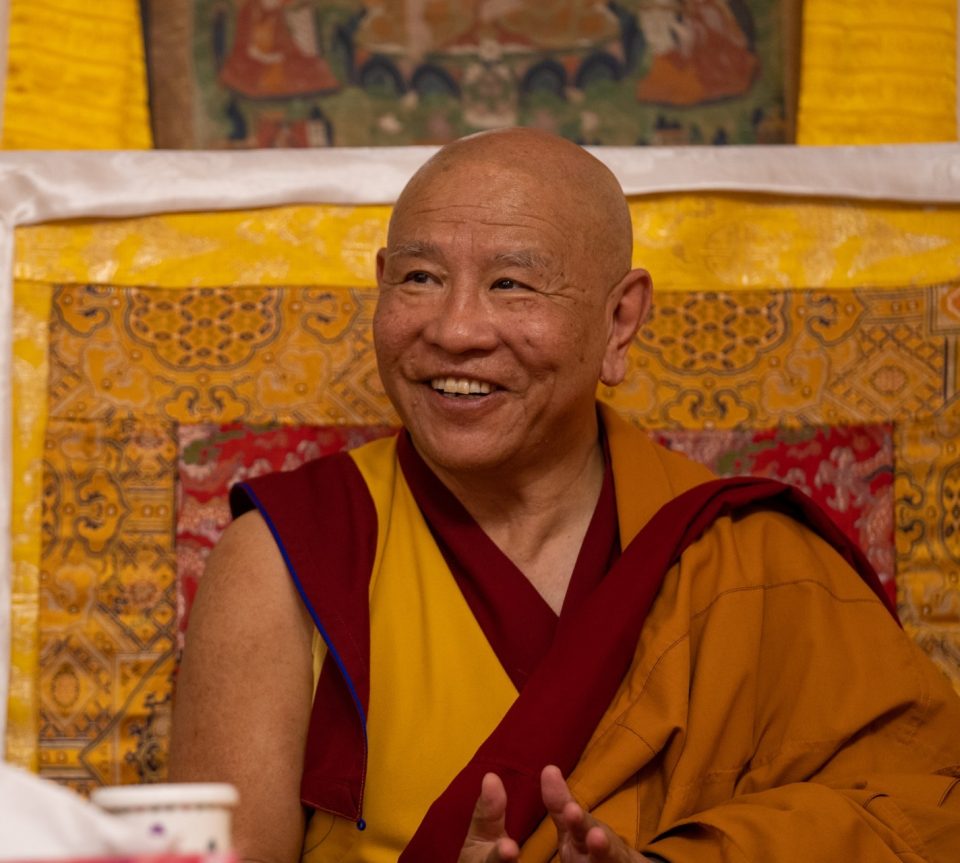
His Eminence Jhado Rinpoche, 2023. Photo by Harald Weichhart.
His Holiness the Dalai Lama offered the complete cycle of the Pure Visions Bearing the Seal of Secrecy of the Great Fifth Dalai Lama (Sangwa Gyachen) in 2005 at Thekchen Choeling Temple in Dharamsala. Among those who received the complete transmission was the past abbot of Namgyal Monastery, H. E. Jhado Rinpoche. Namgyal Monastery is the personal monastery of His Holiness in McLeod Ganj, Dharamsala. To commemorate the twentieth anniversary and in celebration of His Holiness’s 90th birthday, H.E. Jhado Rinpoche will be transmitting the complete cycle of Sangwa Gyachen with initiations, transmissions, and commentaries from March 16-April 3, 2025 in the main temple.
His Holiness is the greatest source of inspiration for the FPMT organization. Lama Zopa Rinpoche said, “[I would like] for FPMT to offer service to His Holiness the Dalai Lama as much as possible and to be able to fulfill His Holiness’ wishes. This is the highest priority for the organization.”
All interested and wishing to attend should contact Namgyal Monastery Office in advance and please refer to the attached poster for information on commitments associated with these teachings.
To support His Holiness’ wish to keep the continuity of this lineage of the 5th Dalai’s Pure Visions cycle, FPMT Education Services is publishing the two practice texts required for this momentous event.
- The Great Compassionate One Embodying the Three Roots
- The Body Maṇḍala Rite of the Display of the Combined Peaceful and Wrathful Kagye
We will share details on how to obtain these materials as soon as they become available.
Foundation for the Preservation of Mahayana Tradition (FPMT), is a Tibetan Buddhist organization dedicated to the transmission of the Mahayana Buddhist tradition and values worldwide through teaching, meditation and community service.
6
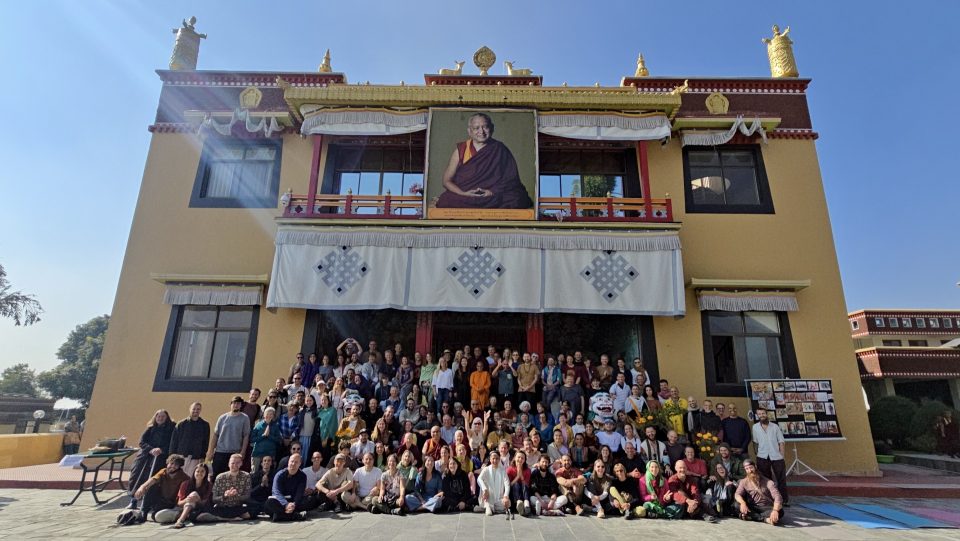
Group photo of the 2024 Kopan Course participants. Photo courtesy of Kopan Monastery.
170 participants from 44 countries participated in Kopan Monastery’s yearly month-long lamrim course, known affectionately as the November Course, which was held November 8 through December 8, 2024. Those in attendance ranged in age from a few 18-year-old first-timers to an 88-year-old long-time student. During the course, 41 participants took refuge with Khenrinpoche Geshe Thubten Chonyi, who taught in the afternoons for the first time. His teachings centered on the Eight Verses of Mind Training, offering practical guidance for participants.
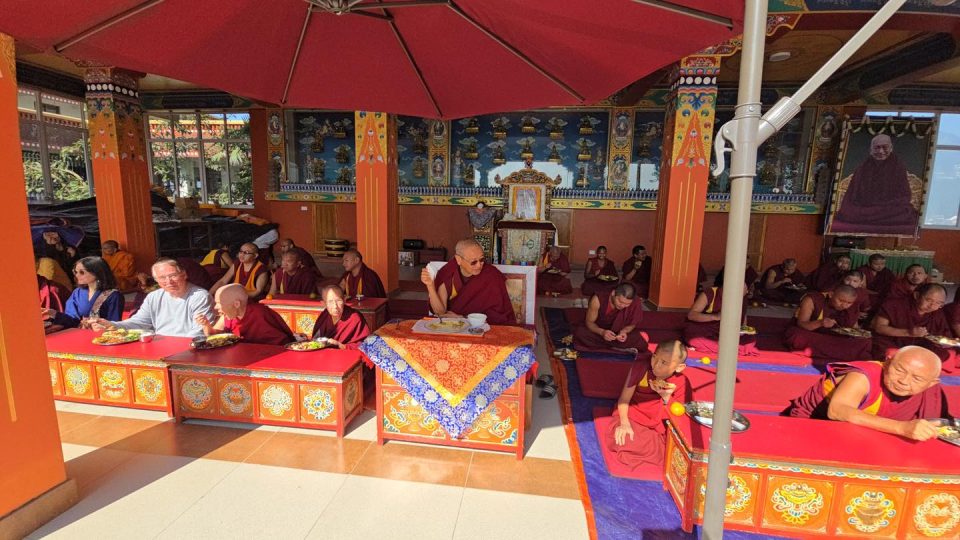
Francisca, Thubten Pende, Ven. Joan Nicell, Ani Karin, Khenrinpoche Geshe Chonyi, Lama Thubten Rigsel Rinpoche, and Ven. Tenpa Choden having lunch during the picnic. Photo courtesy of Kopan Monastery.
One of FPMT’s first Western students, Tubten Pende (aka Jim Dougherty), enriched the course significantly, sharing stories from the early days of the organization, and his experiences with Lama Yeshe and Lama Zopa Rinpoche since 1972.
As usual, many received the Vajrasattva initiation from Khenrinpoche Geshe Thubten Chonyi, and five have already begun the three-month Vajrasattva Retreat at Kopan. The retreat concluded with the traditional picnic, made even more special by the creativity of participants. Several offered Dharma-inspired performances to the sangha and teachers, as well as poetry. Kopan offered three Cham dances, performed by Kopan monks, which added a meaningful cultural element to the event.
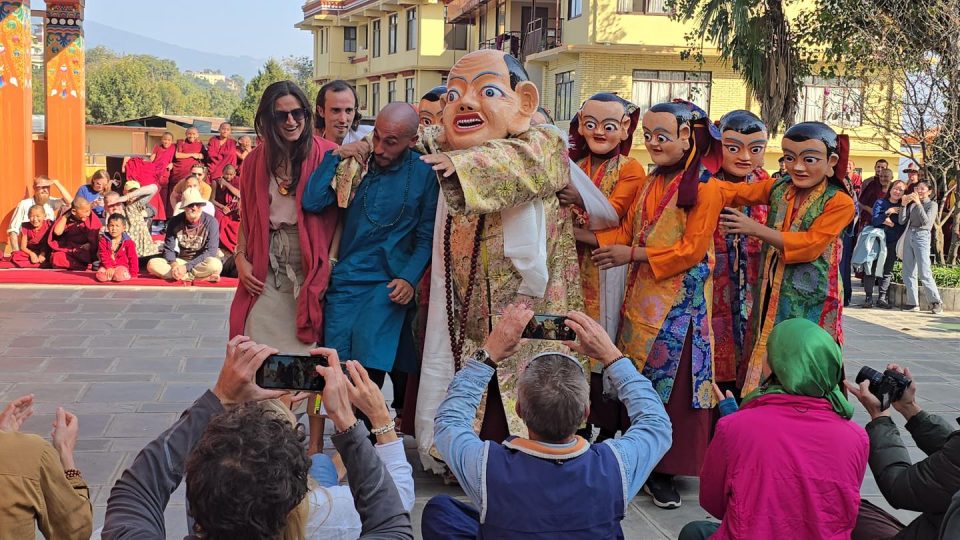
Kopan course participants with Kopan monks following the Cham dances. Photo courtesy of Kopan Monastery.
The first Kopan course was offered in 1971 with a dozen students in attendance. Over the years, an average of 200 spiritual seekers from diverse backgrounds have received the immense blessings of this legendary course. Many of FPMT’s senior students first met Lama Yeshe and Lama Zopa Rinpoche after walking up the beautiful and holy Kopan hill for the month-long retreat. This historic course is responsible for the lamas’ teachings spreading throughout the West as these students established FPMT centers around the world. Please join us in rejoicing in the 2024 course, and we look forward to sharing information on the 2025 course, as it becomes available.
Foundation for the Preservation of Mahayana Tradition (FPMT), is a Tibetan Buddhist organization dedicated to the transmission of the Mahayana Buddhist tradition and values worldwide through teaching, meditation and community service.
- Tagged: kopan course, kopan monastery
5
The Bee Kind Project at Nalanda Monastery
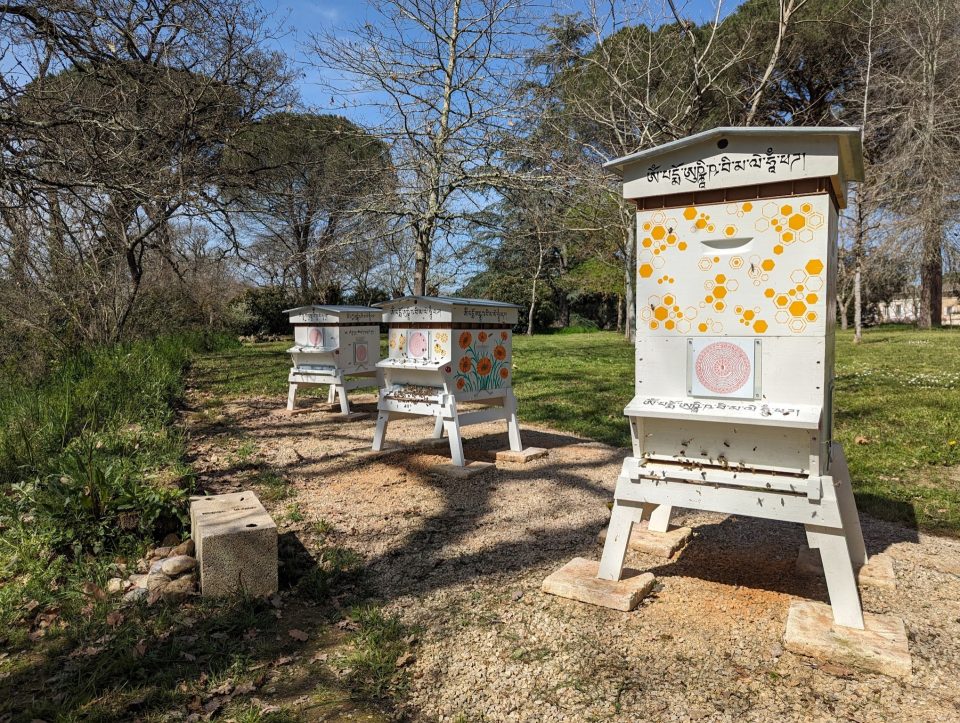
Complete Dharma hives ready for placement of a 3rd honey bee colony in Spring 2024. Flowers painted by Sonam Sherpa. Mantras painted by Ven. Tenzin Yonten. Photo thanks to Ven. Tenzin Yonten.
In May 2023, Nalanda Monastery, France, installed their first honey bee colonies at a secluded spot in the extensive grounds of Maitreya Pure Land, a property adjacent to Nalanda, encompassing 5.5 hectares (13.59 acres) of beautiful parkland which the monastery purchased in 2020.
Their primary objective with this activity, called the Bee Kind Project, is to provide a supportive environment for promoting a genetic line of honey bees resistant to some of the modern challenges that bees have to deal with. Late summer offers the monastery harvestable honey to enjoy and utilize.
“By providing a protected and supportive environment for honey bees, we not only create a deeper appreciation for other sentient beings and the natural world around us, but we also contribute to local ecology in a positive and practical way,” Nalanda explains on their website. “Through the support of strong honey bee populations, we can significantly address their decline caused by habitat loss, pesticides, climate change and invasive predators. Taking action to protect these vital pollinators is essential for a sustainable future in food security and biodiversity.”

All jars of a very limited harvest in our first year were offered to the incredibly kind sponsors who started the project. Photo thanks to Ven. Tenzin Yonten.
Nalanda Monastery focuses on animal welfare through various compassionate initiatives, including the Bee Kind Project. The Animal Care Project as a whole also provides essential nutritional and medical support for feral and lost cats in the area. In addition, it serves as a community resource for advice on injured wildlife, facilitating their care through on-site rehabilitation or advice from a small network, and eventual re-release back into the wild. Additionally, Nalanda creates nesting sites for local songbirds and ensures they have sufficient winter resources.
In this way, Nalanda has been able to contribute in definite ways to relieve the physical suffering of any animal that comes to the monastery for care, in addition to preventing their suffering in future lives through their spiritual care. By fostering a compassionate environment for all sentient beings, Nalanda Monastery can serve to enhance local biodiversity and promote a deeper appreciation for nature.
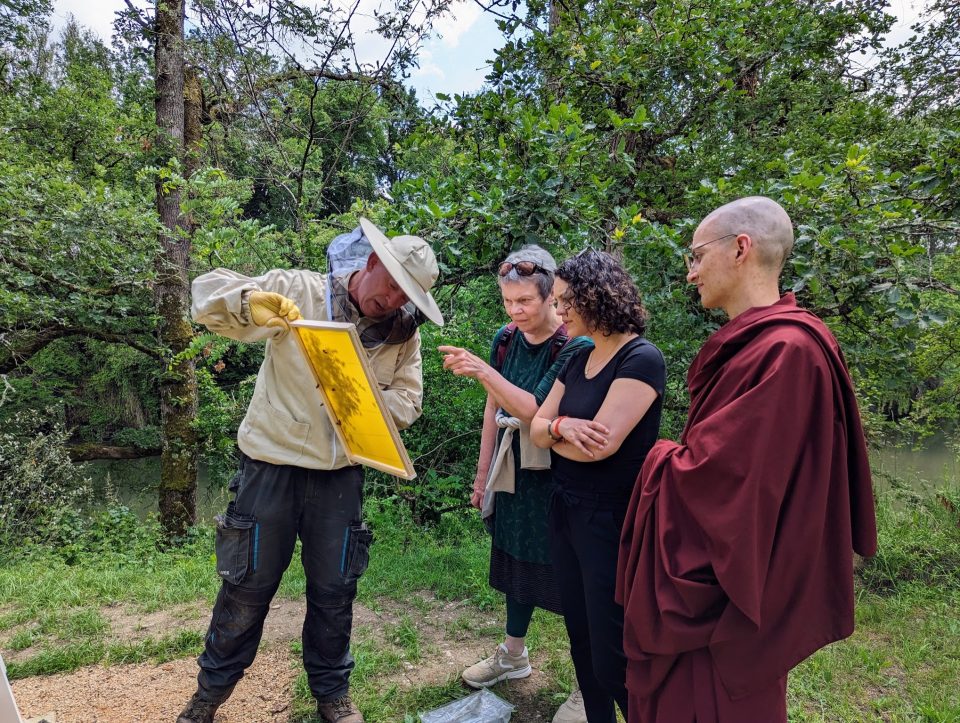
Ven. Tenzin Yonten introducing the world of honey bees to Ven. Tenzin Drolma and her family. Visitors are welcome to visit at any time during the Spring and Summer. Photo thanks to Ven. Tenzin Yonten.
We rejoice in these unique ways Nalanda is supporting sentient beings, and how their Bee Kind Project is contributing directly to local ecology through strong bee populations.
You can learn more about this and all of Nalanda’s animal care projects, and learn how to support their efforts.
Please explore more resources and inspiration for benefiting animals:
fpmt.org/education/prayers-and-practice-materials/benefiting-animals-practices-and-advice
Foundation for the Preservation of Mahayana Tradition (FPMT), is a Tibetan Buddhist organization dedicated to the transmission of the Mahayana Buddhist tradition and values worldwide through teaching, meditation and community service.
- Tagged: animal care, nalanda monastery
- Home
- News/Media
- Study & Practice
- About FPMT Education Services
- Latest News
- Programs
- New to Buddhism?
- Buddhist Mind Science: Activating Your Potential
- Heart Advice for Death and Dying
- Discovering Buddhism
- Living in the Path
- Exploring Buddhism
- FPMT Basic Program
- FPMT Masters Program
- FPMT In-Depth Meditation Training
- Maitripa College
- Lotsawa Rinchen Zangpo Translator Program
- Universal Education for Compassion & Wisdom
- Online Learning Center
- Prayers & Practice Materials
- Overview of Prayers & Practices
- Full Catalogue of Prayers & Practice Materials
- Explore Popular Topics
- Benefiting Animals
- Chenrezig Resources
- Death & Dying Resources
- Lama Chopa (Guru Puja)
- Lama Zopa Rinpoche: Compendium of Precious Instructions
- Lama Zopa Rinpoche: Life Practice Advice
- Lama Zopa Rinpoche Practice Series
- Lamrim Resources
- Mantras
- Prayer Book Updates
- Purification Practices
- Sutras
- Thought Transformation (Lojong)
- Audio Materials
- Dharma Dates – Tibetan Calendar
- Translation Services
- Publishing Services
- Teachings and Advice
- Find Teachings and Advice
- Lama Zopa Rinpoche Advice Page
- Lama Zopa Rinpoche: Compendium of Precious Instructions
- Lama Zopa Rinpoche Video Teachings
- ༧སྐྱབས་རྗེ་བཟོད་པ་རིན་པོ་ཆེ་མཆོག་ནས་སྩལ་བའི་བཀའ་སློབ་བརྙན་འཕྲིན།
- Podcasts
- Lama Yeshe Wisdom Archive
- Buddhism FAQ
- Dharma for Young People
- Resources on Holy Objects
- Ways to Offer Support
- Centers
- Affiliates Area
- Teachers
- Projects
- Charitable Projects
- Make a Donation
- Applying for Grants
- News about Projects
- Other Projects within FPMT
- Support International Office
- Projects Photo Galleries
- Give Where Most Needed
- FPMT
- Shop
Translate*
*powered by Google TranslateTranslation of pages on fpmt.org is performed by Google Translate, a third party service which FPMT has no control over. The service provides automated computer translations that are only an approximation of the websites' original content. The translations should not be considered exact and only used as a rough guide.Proper guru devotion – correct devotion to your virtuous friends – allows you to actualize successfully all the steps of the path to enlightenment, from the perfect human rebirth up to buddhahood itself.







